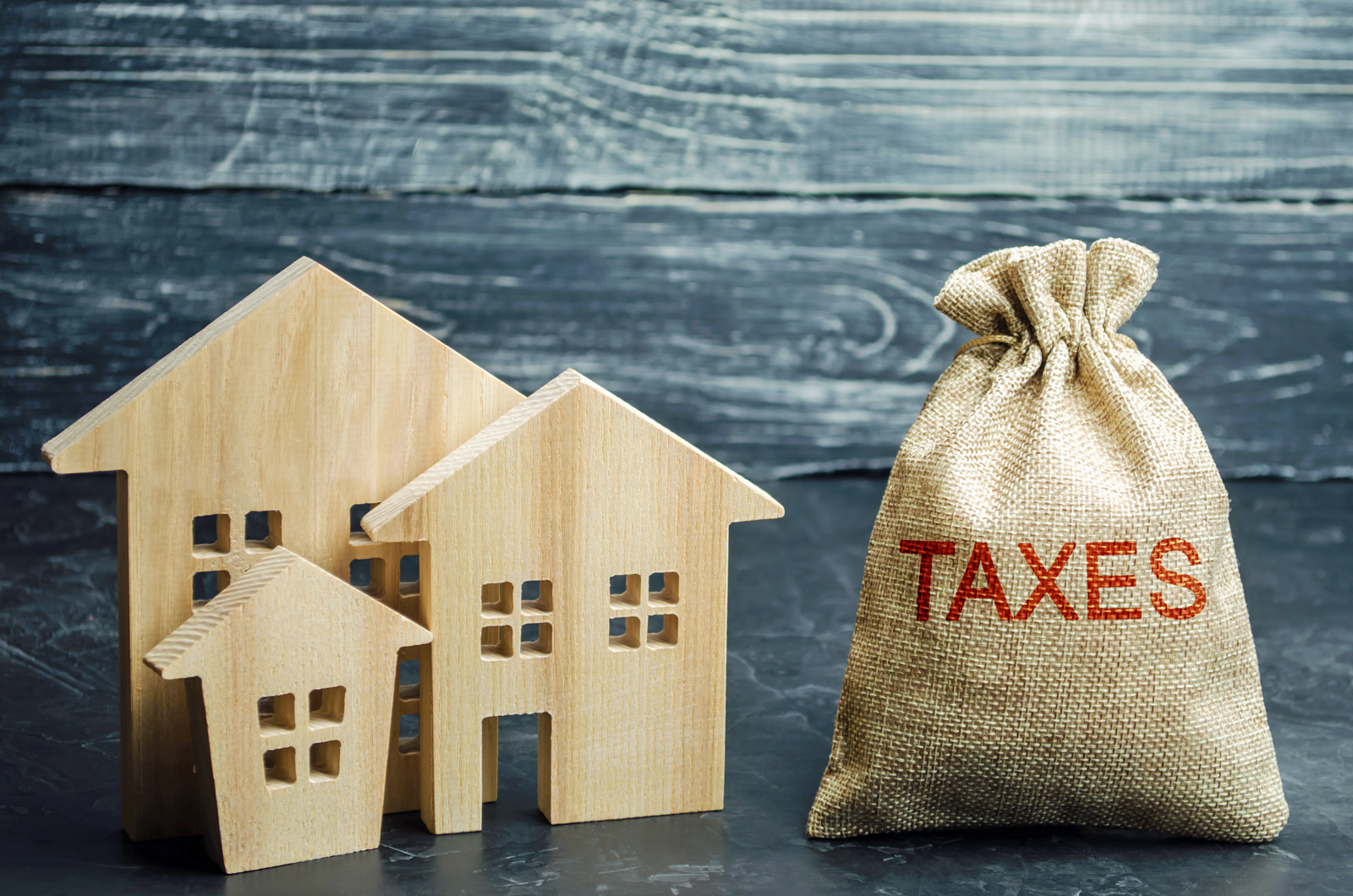 The UK Chancellor of the Exchequer, Rachel Reeves, will present her annual Budget in late autumn. It will involve some hard economic and political choices. The government would like to spend more money on improving public services but has pledged not to raise taxes ‘on working people’, which is interpreted as not raising the rates of income tax, national insurance for employees and the self-employed, and VAT. What is more, government borrowing is forecast by the OBR to be £118 billion, or nearly 4.0% of GDP, for the the year 2025/26. This is a fall from the 5.1% in 2024/25 and is well below the 15.0% in 2020/21 during the pandemic. But it is significantly above the 2.1% in 2018/19.
The UK Chancellor of the Exchequer, Rachel Reeves, will present her annual Budget in late autumn. It will involve some hard economic and political choices. The government would like to spend more money on improving public services but has pledged not to raise taxes ‘on working people’, which is interpreted as not raising the rates of income tax, national insurance for employees and the self-employed, and VAT. What is more, government borrowing is forecast by the OBR to be £118 billion, or nearly 4.0% of GDP, for the the year 2025/26. This is a fall from the 5.1% in 2024/25 and is well below the 15.0% in 2020/21 during the pandemic. But it is significantly above the 2.1% in 2018/19.
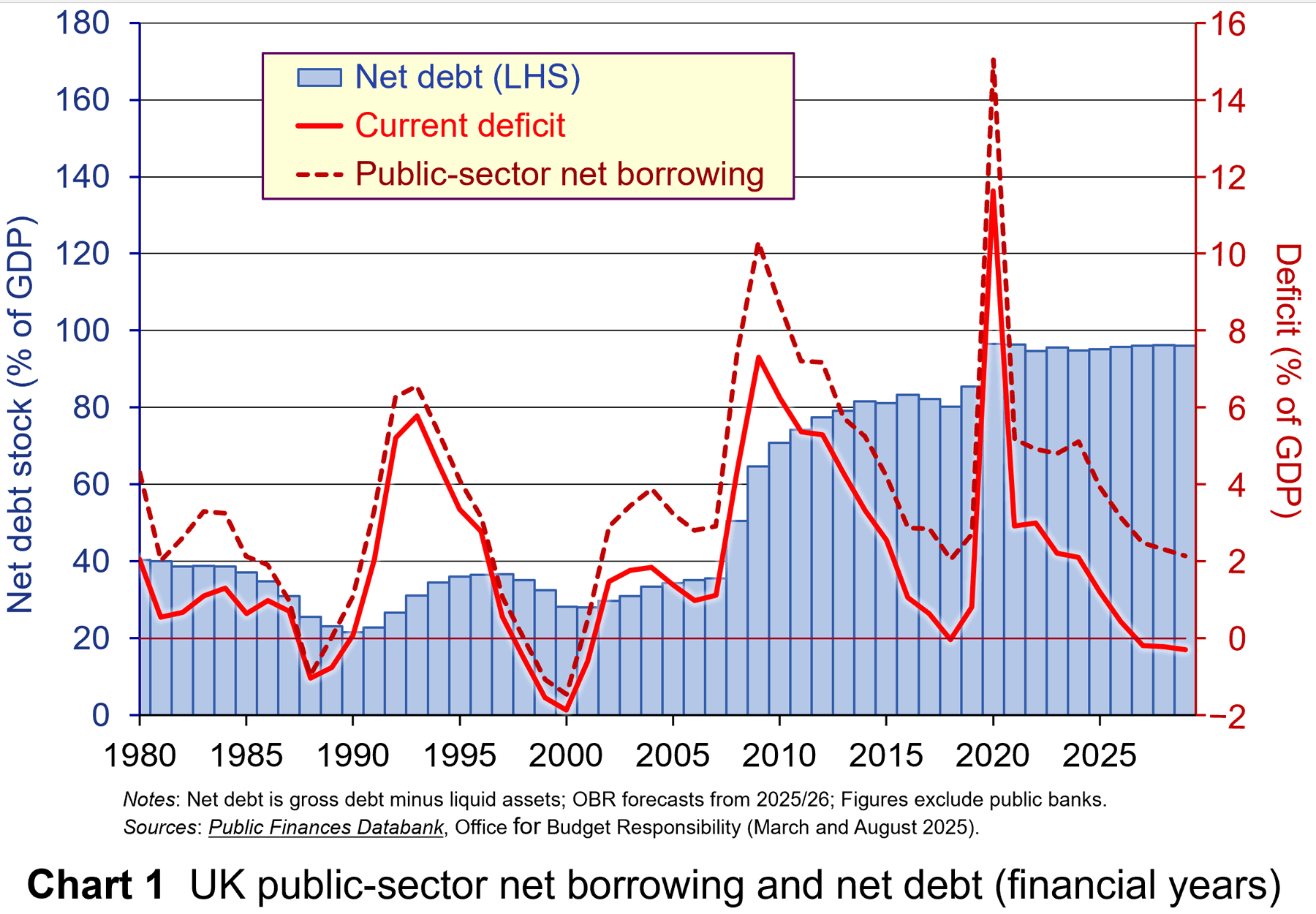 The government has pledged to stick to its two fiscal rules. The first is that the day-to-day, or ‘current’, budget (i.e. excluding investment) should be in surplus or in deficit of no more than 0.5 per cent of GDP by 2029/30 (or the third year of the rolling forecast period from the 2026/27 Budget). This allows investment to be funded by borrowing. The second rule is that public-sector net debt, which includes public-sector debt plus pension liabilities minus equity, loans and other financial assets, should be falling by 2029/30 (or the third year of the rolling forecast period from the 2026/27 Budget). The current budget deficit (i.e. excluding borrowing for investment) was forecast by the OBR in March to be 1.2% of GDP for 2025/26 (see Chart 1) and to be a surplus of 0.3% in 2029/30 (£9.9 billion). (Click here for a PowerPoint of the chart.)
The government has pledged to stick to its two fiscal rules. The first is that the day-to-day, or ‘current’, budget (i.e. excluding investment) should be in surplus or in deficit of no more than 0.5 per cent of GDP by 2029/30 (or the third year of the rolling forecast period from the 2026/27 Budget). This allows investment to be funded by borrowing. The second rule is that public-sector net debt, which includes public-sector debt plus pension liabilities minus equity, loans and other financial assets, should be falling by 2029/30 (or the third year of the rolling forecast period from the 2026/27 Budget). The current budget deficit (i.e. excluding borrowing for investment) was forecast by the OBR in March to be 1.2% of GDP for 2025/26 (see Chart 1) and to be a surplus of 0.3% in 2029/30 (£9.9 billion). (Click here for a PowerPoint of the chart.)
The OBR’s March forecasts, therefore, were that the rules would be met with current policies and that the average rate of economic growth would be 1.8% over the next four years.
However, there would be very little room for manoeuvre, and with global political and economic uncertainty, including the effects of tariffs, climate change on harvests and the continuing war in Ukraine, the rate of economic growth might be well below 1.8%.
The March forecasts were based on the assumption that inflation would fall and hence that the Bank of England would reduce interest rates. Global pressure on inflation, however, might result in inflation continuing to be above the Bank of England’s target of 2%. This would mean that interest rates would be slow to fall – if at all. This would dampen growth and make it more expensive for the government to service the public-sector debt, thus making it harder to reduce the public-sector deficit.
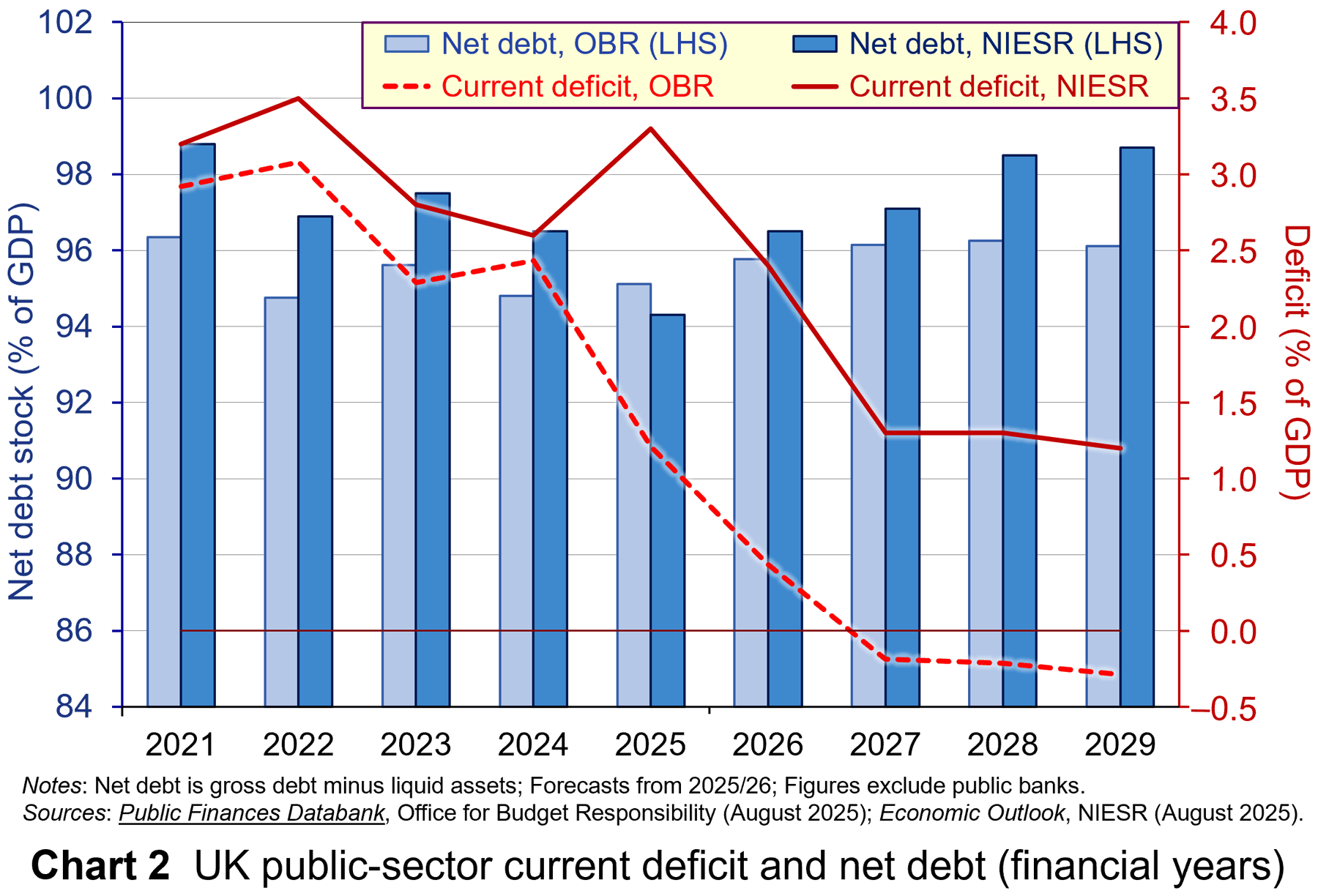 A forecast earlier this month by the National Institute for Economic and Social Research (NIESR) (see link below and Chart 2) reflects these problems and paints a gloomier picture than the OBR’s March forecast. The NIESR forecasts that GDP will grow by only 1.3 per cent in 2025, 1.2 per cent in 2026, 1.1% in 2027 and 1.0% in 2028, with the average for 2025 to 2023 being 1.13%. This is the result of high levels of business uncertainty and the effects of tariffs on exports. With no change in policy, the current deficit would be £41.2 billion in the 2029/30 financial year. Inflation would fall somewhat, but would stick at around 2.7% from 2028 to 2030. Net debt would be rising in 2029/30 &ndash but only slightly, from 98.7% to 99.0%. (Click here for a PowerPoint of the chart.)
A forecast earlier this month by the National Institute for Economic and Social Research (NIESR) (see link below and Chart 2) reflects these problems and paints a gloomier picture than the OBR’s March forecast. The NIESR forecasts that GDP will grow by only 1.3 per cent in 2025, 1.2 per cent in 2026, 1.1% in 2027 and 1.0% in 2028, with the average for 2025 to 2023 being 1.13%. This is the result of high levels of business uncertainty and the effects of tariffs on exports. With no change in policy, the current deficit would be £41.2 billion in the 2029/30 financial year. Inflation would fall somewhat, but would stick at around 2.7% from 2028 to 2030. Net debt would be rising in 2029/30 &ndash but only slightly, from 98.7% to 99.0%. (Click here for a PowerPoint of the chart.)
So what are the policy options open to the government for dealing with a forecast current budget deficit of £41.2 billion (1.17% of GDP)? There are only three broad options.
Increase borrowing
One approach would be to scrap the fiscal rules and accept increased borrowing – at least temporarily. This would avoid tax increases or expenditure cuts. By running a larger budget deficit, this Keynesian approach would also have the effect of increasing aggregate demand and, other things being equal, could lead to a multiplied rise in national income. This in turn would lead to higher tax revenues and thereby result in a smaller increase in borrowing.
There are two big problems with this approach, however.
The first is that it would, over time, increase the public-sector debt and would involve having to spend more each year on servicing that debt. This would leave less tax revenue for current spending or investment. It would also involve having to pay higher interest rates to encourage people to buy the additional new government bonds necessary to finance the increased deficit.
 The second problem is that the Chancellor has said that she will stick to the fiscal rules. If she scraps them, if only temporarily, she runs the risk of losing the confidence of investors. This could lead to a run on the pound and even higher interest rates. This was a problem under the short-lived Liz Truss government when the ‘mini’ Budget of September 2022 made unfunded pledges to cut taxes. There was a run on the pound and the Bank of England had to make emergency gilt purchases.
The second problem is that the Chancellor has said that she will stick to the fiscal rules. If she scraps them, if only temporarily, she runs the risk of losing the confidence of investors. This could lead to a run on the pound and even higher interest rates. This was a problem under the short-lived Liz Truss government when the ‘mini’ Budget of September 2022 made unfunded pledges to cut taxes. There was a run on the pound and the Bank of England had to make emergency gilt purchases.
One possibility that might be more acceptable to markets would be to rewrite the investment rule. There could be a requirement on government to invest a certain proportion of GDP (say, 3%) and fund it by borrowing. The supply-side benefits could be faster growth in potential output and higher tax revenue over the longer term, allowing the current deficit rule to be met.
Cut government expenditure
Politicians, especially in opposition, frequently claim that the solution is to cut out public-sector waste. This would allow public expenditure to be cut without cutting services. This, however, is harder than it might seem. There have been frequent efficiency drives in the public sector, but from 1919 to 2023 public-sector productivity fell by an average of 0.97% per year.
Causes include: chronic underinvestment in capital, resulting in outdated equipment and IT systems and crumbling estates; decades of underfunding that have left public services with crumbling estates, outdated equipment and insufficient IT systems; inconsistent, short-term government policy, with frequent changes in government priorities; bureaucratic systems relying on multiple legacy IT systems; workforce challenges, especially in health and social care, with high staff turnover, recruitment difficulties, and a lack of experienced staff.
 The current government has launched a Public Sector Productivity Programme. This is a a cross-government initiative to improve productivity across public services. Departments are required to develop productivity plans to invest in schemes designed to achieve cost savings and improve outcomes in areas such as the NHS, police, and justice system. A £1.8 billion fund was announced in March 2024, to support public-sector productivity improvements and digital transformation. Part of this is to be invested in digital services and AI to improve efficiency. According to the ONS, total public-service productivity in the UK grew by 1.0% in the year to Q1 2025; healthcare productivity grew 2.7% over the same period. It remains to be seen whether this growth in productivity will be maintained. Pressure from the public, however, will mean that any gains are likely to be in terms of improved services rather than reduced government expenditure.
The current government has launched a Public Sector Productivity Programme. This is a a cross-government initiative to improve productivity across public services. Departments are required to develop productivity plans to invest in schemes designed to achieve cost savings and improve outcomes in areas such as the NHS, police, and justice system. A £1.8 billion fund was announced in March 2024, to support public-sector productivity improvements and digital transformation. Part of this is to be invested in digital services and AI to improve efficiency. According to the ONS, total public-service productivity in the UK grew by 1.0% in the year to Q1 2025; healthcare productivity grew 2.7% over the same period. It remains to be seen whether this growth in productivity will be maintained. Pressure from the public, however, will mean that any gains are likely to be in terms of improved services rather than reduced government expenditure.
Increase taxes
This is always a controversial area. People want better public services but also reduced taxes – at least for themselves! Nevertheless, it is an option seriously being considered by the government. However, if it wants to avoid raising the rates of income tax, national insurance for employees and the self-employed, and VAT, its options are limited. It has also to consider the political ramifications of taking unpopular tax-raising measures. The following are possibilities:
Continue the freeze on income tax bands. They are currently frozen until April 2028. The extra revenue from extending the freeze until April 2030 would be around £7 billion. Although this may be politically more palatable than raising the rate of income tax, the revenue raised will be well short of the amount required and thus other measures will be required. Although some £40 billion will have been raised up to 2028 (which has already been factored in), as inflation falls, so the fiscal drag effect will fall: nominal incomes will need to rise less to achieve any given rise in real incomes.
 Cutting tax relief for pensions. Currently, people get income tax relief at their marginal rate on pension contributions made by themselves and their employer up to £60 000 per year or 100% of their earnings, whichever is smaller. When people draw on their pension savings, they pay income tax at their marginal rate, even if the size of their savings has grown from capital gains, interest or dividends. Reducing the limits or restricting relief to the basic rate of tax could make a substantial contribution to increasing government revenue. In 2023/24, pension contribution relief cost the government £52 billion. Restricting relief to the basic rate or cutting the annual limit would make the relief less regressive. In such a case, when people draw on their pension savings, the income tax rate could be limited to the basic rate to avoid double taxation.
Cutting tax relief for pensions. Currently, people get income tax relief at their marginal rate on pension contributions made by themselves and their employer up to £60 000 per year or 100% of their earnings, whichever is smaller. When people draw on their pension savings, they pay income tax at their marginal rate, even if the size of their savings has grown from capital gains, interest or dividends. Reducing the limits or restricting relief to the basic rate of tax could make a substantial contribution to increasing government revenue. In 2023/24, pension contribution relief cost the government £52 billion. Restricting relief to the basic rate or cutting the annual limit would make the relief less regressive. In such a case, when people draw on their pension savings, the income tax rate could be limited to the basic rate to avoid double taxation.
Raising the rate of inheritance tax (IHT) or reducing the threshold. Currently, estates worth more than £325 000 are taxed at a marginal rate of 40%. The threshold is frozen until 2029/30 and thus additional revenue will be received by the government as asset prices increase. If the rate is raised above 40%, perhaps in bands, or the threshold were lowered, then this will earn additional revenue. However, the amount will be relatively small compared to the predicted current deficit in 2029/30 of £41 billion. Total IHT revenue in 2022/23 was only 6.7 billion. Also, it is politically dangerous as people could claim that the government was penalising people who had saved in order to help the next generation, who are struggling with high rents or mortgages.
Increased taxes on business. The main rate of corporation tax was raised from 19% to 25% in April 2023 and the employers’ national insurance rate was raised from 13.8% to 15% and the threshold reduced from £9100 to £5000 per year in April 2025. There is little or no scope for raising business taxes without having significant disincentive effects on investment and employment. Also, there is the danger that raising rates might prompt companies to relocate abroad.
 Raise fuel and/or other duties. Fuel duties raise approximately £24 billion. They are set to decline gradually with the shift to EVs and more fuel-efficient internal combustion engines. Fuel duty remained unchanged at 57.95p per litre from 2011 to 2022 and then was ‘temporarily’ cut to 52.95p. The rate of 52.95p is set to remain until at least 2026. There is clearly scope here to raise it, if only by the rate of inflation each year. Again, the main problem is a political one that drivers and the motor lobby generally will complain. Other duties include alcohol, tobacco/cigarettes/vaping, high-sugar beverages and gambling. Again, there is scope for raising these. There are two problems here. The first is that these duties are regressive, falling more heavily on poorer people. The second is that high duties can encourage illegal trade in these products.
Raise fuel and/or other duties. Fuel duties raise approximately £24 billion. They are set to decline gradually with the shift to EVs and more fuel-efficient internal combustion engines. Fuel duty remained unchanged at 57.95p per litre from 2011 to 2022 and then was ‘temporarily’ cut to 52.95p. The rate of 52.95p is set to remain until at least 2026. There is clearly scope here to raise it, if only by the rate of inflation each year. Again, the main problem is a political one that drivers and the motor lobby generally will complain. Other duties include alcohol, tobacco/cigarettes/vaping, high-sugar beverages and gambling. Again, there is scope for raising these. There are two problems here. The first is that these duties are regressive, falling more heavily on poorer people. The second is that high duties can encourage illegal trade in these products.
Raising one of the three major taxes: income tax, employees’ national insurance and VAT. This will involve reneging on the government’s election promises. But perhaps it’s better to bite the bullet and do it sooner rather than later. Six European countries have VAT rates of 21%, three of 22%, three of 23%, two of 24%, four of 25%, one of 25.5% and one of 27%. Each one percentage point rise would raise about 9 billion. A one percentage point rise across all UK income tax rates would raise around £5.8 billion. As far as employees’ national insurance rates are concerned, the Conservative government reduced the main rate twice from 12% to 10% in January 2024 and from 10% to 8% in April 2024. The government could argue that raising it back to, say, 10% would still leave it lower than previously. A rise to 10% would raise around £11 billion.
Conclusion
The choices for the Chancellor are not easy. As the NIESR’s Economic Outlook puts it:
Simply put, the Chancellor cannot simultaneously meet her fiscal rules, fulfil spending commitments, and uphold manifesto promises to avoid tax rises for working people. At least one of these will need to be dropped – she faces an impossible trilemma.
Articles
- The Chancellor’s Trilemma
UK Economic Outlook: NIESR, Benjamin Caswell, Fergus Jimenez-England, Hailey Low, Stephen Millard, Eliza da Silva Gomes, Adrian Pabst, Tibor Szendrei and Arnab Bhattacharjee (6/8/25)
- Reeves must raise tax to cover £41bn gap, says think tank
BBC News, Lucy Hooker (6/8/25)
- Chancellor warned ‘substantial tax rises’ needed – as she faces ‘impossible trilemma’
Sky News, Gurpreet Narwan (6/8/25)
- Rachel Reeves needs to put up taxes to cover £40bn deficit, thinktank says
The Guardian, Phillip Inman (6/8/25)
- What’s the secret to fixing the UK’s public finances? Here’s what our panel of experts would do
The Conversation, Steve Schifferes, Conor O’Kane, Guilherme Klein Martins, Jonquil Lowe and Maha Rafi Atal (15/8/25)
- Why radical tax reform may be only way for Reeves to balance the books
The Guardian, Phillip Inman (21/8/25)
- Reeves and Starmer to prepare ground for tax rises in a difficult autumn budget
The Guardian, Jessica Elgot, Richard Partington and Eleni Courea (7/8/25)
- How much money does the UK government borrow, and does it matter?
BBC News (21/8/25)
- More pain for Reeves as government borrowing cost nears 27-year high
The Guardian, Phillip Inman (26/8/25)
Data
Questions
- Which of the options would you choose and why?
- Should the government introduce a wealth tax on people with wealth above, say, £2 million? If so, should it be a once-only tax or an annual tax?
- Research another country’s fiscal position and assess the choices their finance minister took.
- Look at a previous UK Budget from a few years ago and the forecasts on which the Budget decisions were made (search Budget [year] on the GOV.UK website). How accurate did the forecasts turn out to be? If the Chancellor then had known what would actually happen in the future, would their decisions have been any different and, if so, in what ways?
- Should fiscal decisions be based on forecasts for three of four years hence when those forecasts are likely to be unreliable?
- Should fiscal and monetary policy decisions be made totally separately from each other?
 The UK Chancellor of the Exchequer, Jeremy Hunt, delivered his Spring Budget on 6 March 2024. In his speech, he announced a cut in national insurance (NI): a tax paid by workers on employment or self-employment income. The main rate of NI for employed workers will be cut from 10% to 8% from 6 April 2024. This follows a cut this January from 12% to 10%. The rate for the self-employed will be cut from 9% to 6% from 6 April. These will be the new marginal rates from the NI-free threshold of £12 750 to the higher threshold of £50 270 (above which the marginal rate is 2% and remains unchanged). Unlike income tax, NI applies only to income from work (employment or self-employment) and does not include pension incomes, rent, interest and dividends.
The UK Chancellor of the Exchequer, Jeremy Hunt, delivered his Spring Budget on 6 March 2024. In his speech, he announced a cut in national insurance (NI): a tax paid by workers on employment or self-employment income. The main rate of NI for employed workers will be cut from 10% to 8% from 6 April 2024. This follows a cut this January from 12% to 10%. The rate for the self-employed will be cut from 9% to 6% from 6 April. These will be the new marginal rates from the NI-free threshold of £12 750 to the higher threshold of £50 270 (above which the marginal rate is 2% and remains unchanged). Unlike income tax, NI applies only to income from work (employment or self-employment) and does not include pension incomes, rent, interest and dividends.
The cuts will make all employed and self-employed people earning more than £12 750 better off than they would have been without them. For employees on average incomes of £35 000, the two cuts will be worth £900 per year.
But will people end up paying less direct tax (income tax and NI) overall than in previous years? The answer is no because of the issue of fiscal drag (see the blog, Inflation and fiscal drag). Fiscal drag refers to the dampening effect on aggregate demand when higher incomes lead to a higher proportion being paid in tax. It occurs when there is a faster growth in incomes than in tax thresholds. This means that (a) the tax-free allowance accounts for a smaller proportion of people’s incomes and (b) a higher proportion of many people’s incomes will be paid at the higher income tax rate. Fiscal drag is especially acute when thresholds are frozen, when inflation is rapid and when real incomes rise rapidly.
Tax thresholds have been frozen since 2021 and the government plans to keep them frozen until 2028. This is illustrated in the following table.

According to the Institute for Fiscal Studies, the net effect of fiscal drag means that for every £1 given back to employed and self-employed workers by the NI cuts, £1.30 will have been taken away as a result of freezing thresholds between 2021 and 2024. This will rise to £1.90 in 2027/28.
 Tax revenues are still set to rise as a percentage of GDP. This is illustrated in the chart. Tax revenues were 33.2% of GDP in 2010/11. By 2022/23 the figure had risen to 36.3%. With neither of the two changes to NI (January 2024 and April 2024), the OBR forecasts that the figure would rise to 37.7% by 2028/29 – the top dashed line in the chart. After the first cut, announced in November, it forecasts a smaller rise to 37.3% – the middle dashed line. After the second cut, announced in the Spring Budget, the OBR cut the forecast figure to 37.1% – the bottom dashed line. (Click here for a PowerPoint of the chart.)
Tax revenues are still set to rise as a percentage of GDP. This is illustrated in the chart. Tax revenues were 33.2% of GDP in 2010/11. By 2022/23 the figure had risen to 36.3%. With neither of the two changes to NI (January 2024 and April 2024), the OBR forecasts that the figure would rise to 37.7% by 2028/29 – the top dashed line in the chart. After the first cut, announced in November, it forecasts a smaller rise to 37.3% – the middle dashed line. After the second cut, announced in the Spring Budget, the OBR cut the forecast figure to 37.1% – the bottom dashed line. (Click here for a PowerPoint of the chart.)
As you can see from the chart, despite the cut in NI rates, the fiscal drag from freezing thresholds means that tax revenue as a percentage of GDP is still set to rise.
Articles
Information, data and analysis
Questions
- Would fiscal drag occur with frozen nominal tax bands if there were zero real growth in incomes? Explain.
- Find out what happened to other taxes, benefits, reliefs and incentives in the 2024 Spring Budget. Assess their macroeconomic effect.
- If the government decides that it wishes to increase tax revenues as a proportion of GDP (for example, to fund increased government expenditure on infrastructure and socially desirable projects and benefits), examine the arguments for increasing personal allowances and tax bands in line with inflation but raising the rates of income tax in order to raise sufficient revenue?
- Distinguish between market-orientated and interventionist supply-side policies? Why do political parties differ in their approaches to supply-side policy?
- What is the Conservative government’s fiscal rule? Is the Spring Budget 2024 consistent with this rule?
- What policies were announced in the Spring Budget 2024 to increase productivity? Why is it difficult to estimate the financial outcome of such policies?
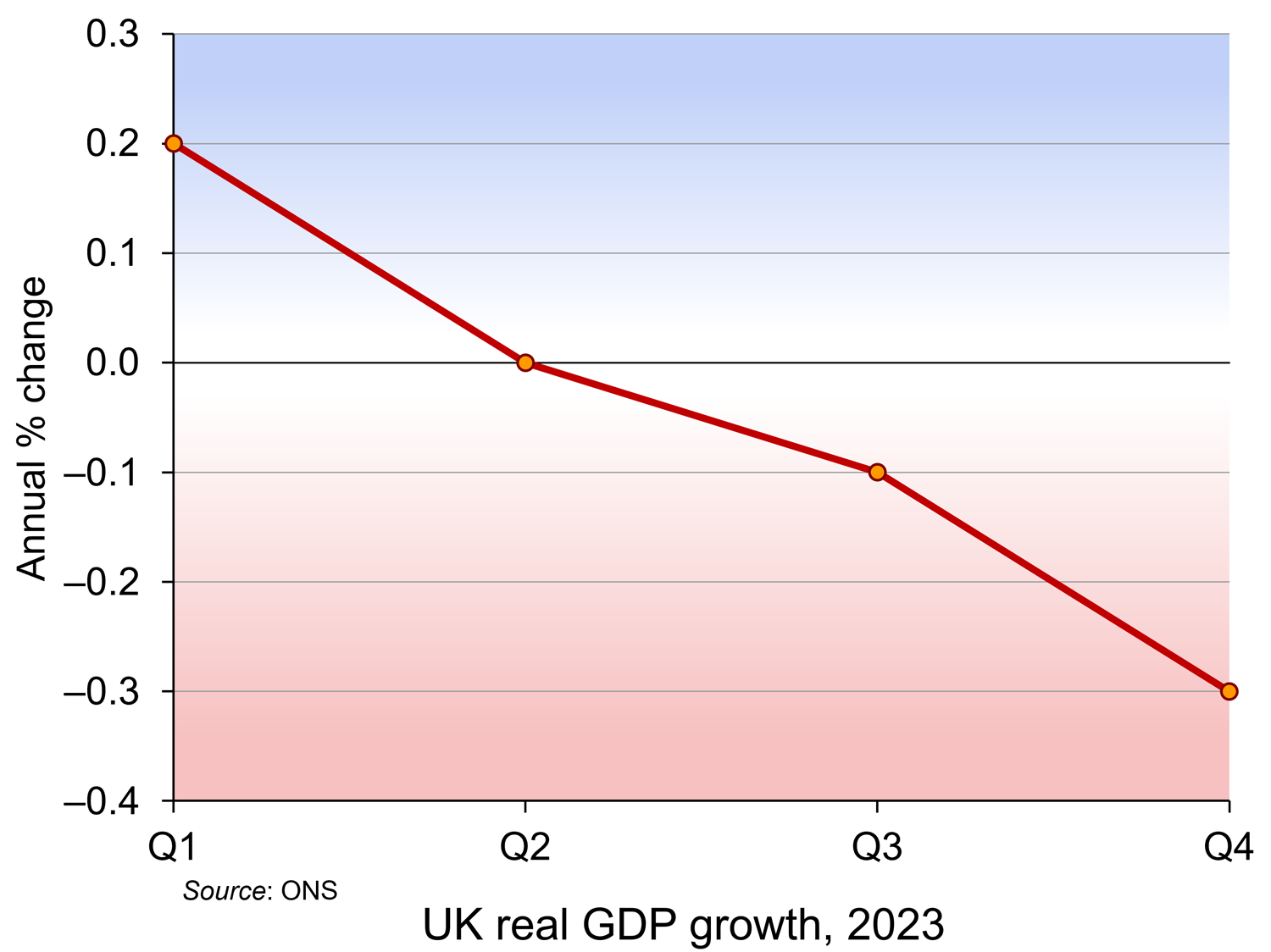 Latest figures from the Office for National Statistics show that the UK was in recession at the end of 2023. The normal definition of recession is two quarters of falling real GDP. This is what happened to the UK in the last two quarters of 2023, with GDP falling by 0.1% in Q3 and 0.3% in Q4. In Q4, output of the service industries fell by 0.2%, production industries by 1.0% and construction by 1.3%.
Latest figures from the Office for National Statistics show that the UK was in recession at the end of 2023. The normal definition of recession is two quarters of falling real GDP. This is what happened to the UK in the last two quarters of 2023, with GDP falling by 0.1% in Q3 and 0.3% in Q4. In Q4, output of the service industries fell by 0.2%, production industries by 1.0% and construction by 1.3%.
But how bad is this? What are the implications for living standards? In some respects, the news is not as bad as the term ‘recession’ might suggest. In other respects, it’s worse than the headline figures might imply.
The good news (or not such bad news)
The first thing to note is that other countries too experienced a recession or slowdown in the second half of 2023. So, relative to these countries, the UK is not performing that badly. Japan, for example, also experienced a mild recession; Germany just missed one. These poor economic growth rates were caused largely by higher global energy and food prices and by higher central bank interest rates in response. The good news is that such cost pressures are already easing.
The second piece of good news is that GDP is expected to start growing again (modestly) in 2024. This will be helped by the Bank of England cutting interest rates. The Monetary Policy Committee is expected to do this at its May, June or August meetings provided that inflation falls. Annual CPI inflation was 4% in January – the same as in December. But it is expected to fall quite rapidly over the coming months provided that there are no serious supply-side shocks (e.g. from world political factors).
The third is that the recession is relatively modest compared with ones in the past. In the recession following the financial crisis, real GDP fell by 5.3% in 2009; during the pandemic, GDP fell by 10.7% in 2020. For this reason, some commentators have said that the last two quarters of 2023 represent a mere ‘technical recession’, with the economy expected to grow again in 2024.
Why things may be worse than the headline figures suggest
Real GDP per head
So far we have considered real GDP (i.e. GDP adjusted for inflation). But if changes in GDP are to reflect changes in living standards, we need to consider real GDP per head. Population is rising. This means that the rate of growth in real GDP per head is lower than the rate of growth in real GDP
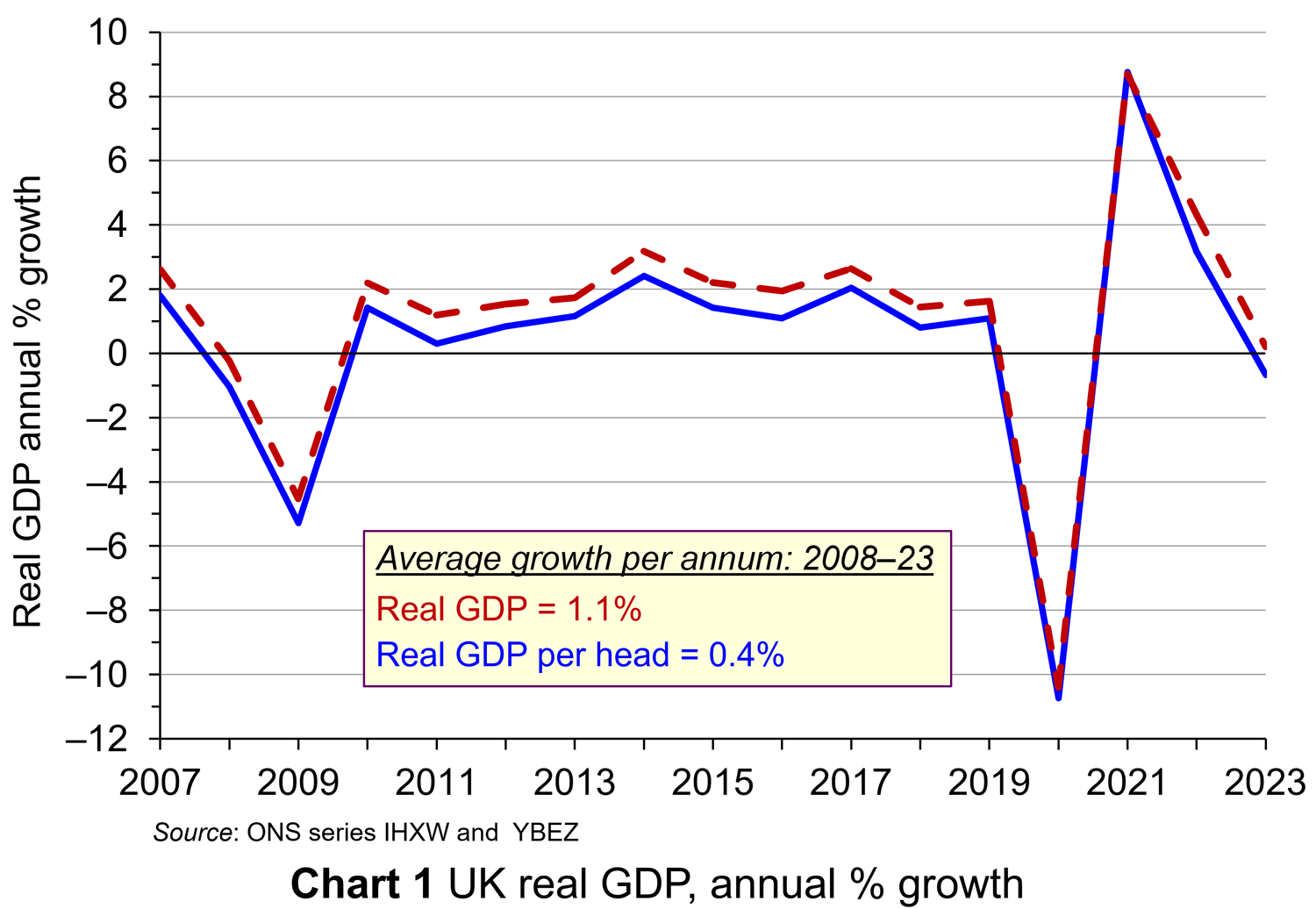 For 2023 as a whole, while real GDP rose by 0.20%, real GDP per head fell by 0.67%. In the last two quarters of 2023, while real GDP fell by 0.1% and 0.3% respectively, real GDP per head fell by 0.4% and 0.6%, respectively, having already fallen in each of the previous five quarters. Chart 1 shows real GDP growth and real GDP growth per head from 2007 to 2023 (click here for a PowerPoint). As you can see, given population growth, real GDP per head has consistently grown slower than real GDP.
For 2023 as a whole, while real GDP rose by 0.20%, real GDP per head fell by 0.67%. In the last two quarters of 2023, while real GDP fell by 0.1% and 0.3% respectively, real GDP per head fell by 0.4% and 0.6%, respectively, having already fallen in each of the previous five quarters. Chart 1 shows real GDP growth and real GDP growth per head from 2007 to 2023 (click here for a PowerPoint). As you can see, given population growth, real GDP per head has consistently grown slower than real GDP.
Long-term trends.
If we are assessing the UK’s potential for growth in GDP, rather than the immediate past, it is useful to look at GDP growth over a longer period. Looking at past trend growth rates and explaining them can give us an indication of the likely future path of the growth in GDP – at least in the absence of a significant change in underlying economic factors. Since 2007, the average annual rate of growth of real GDP has been only 1.1% and that of real GDP per head a mere 0.4%.
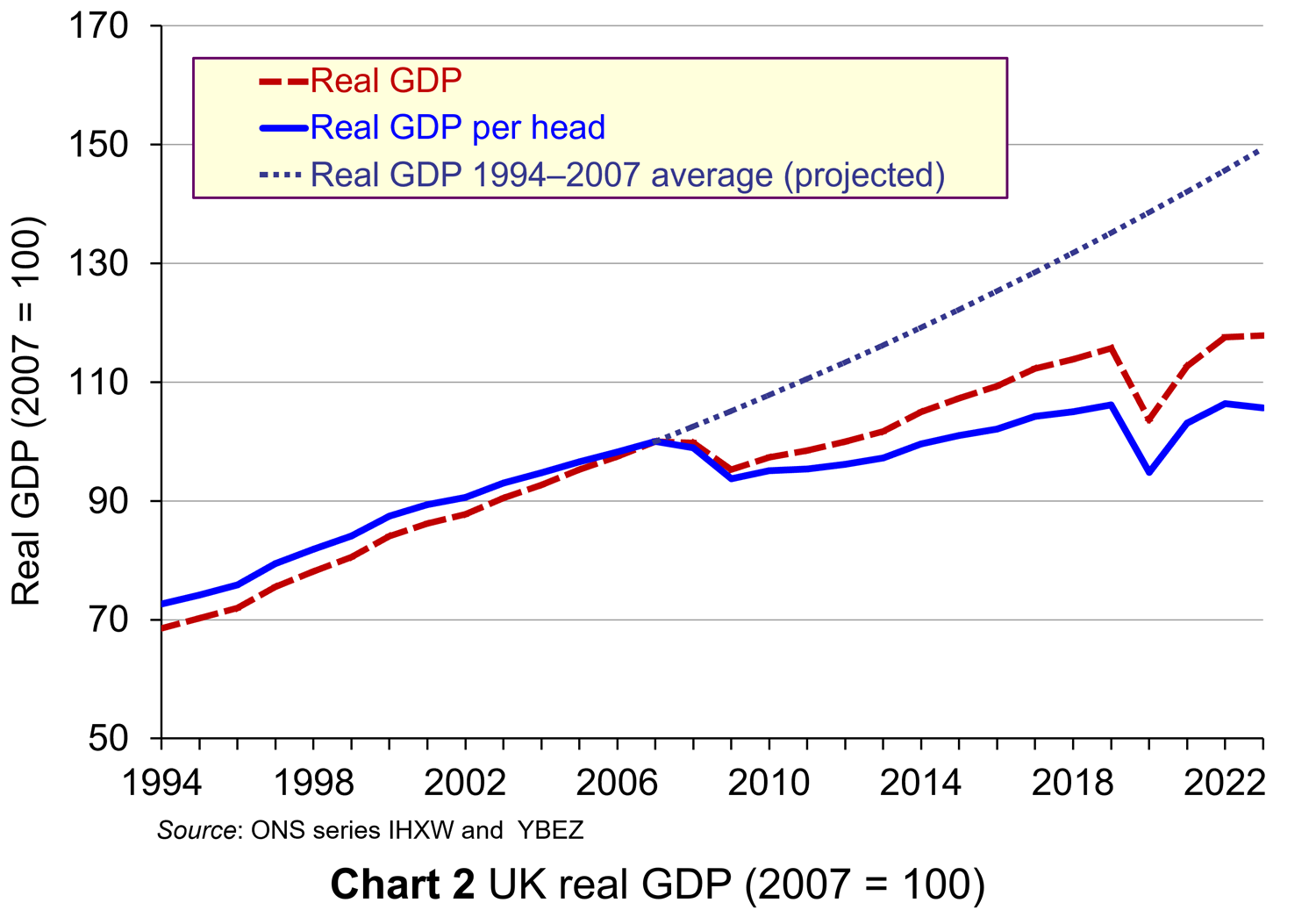 This compares unfavourably with the period from 1994 to 2007, when the average annual rate of growth of real GDP was 3.0% and that of real GDP per head was 2.5%.
This compares unfavourably with the period from 1994 to 2007, when the average annual rate of growth of real GDP was 3.0% and that of real GDP per head was 2.5%.
This is illustrated in Chart 2 (click here for a PowerPoint). The chart also projects the growth rate in GDP per head of 2.5% forward from 2007 to 2023. Had this growth rate been achieved since 2007, GDP per head in 2023 would have been 41.4% higher than it actually was.
It is not only the UK that has seen low growth over the past 15 years compared to previous years. It has achieved a similar average annual growth rate over the period to Germany (1.1%), lower rates than the USA (1.8%) and Canada (1.6%), but higher than France (0.9%) and Japan (0.4%).
Low investment
A key determinant of economic growth is investment. Since 2008, the UK has invested an average of 17.3% of GDP. This is the lowest of the G7 countries and compares with 24.9% in Japan, 23.7% in Canada, 23.5% in France, 21.3% in Germany, 20.4% in the USA and 19.1% in Italy. If UK growth is to recover strongly over the longer term, the rate of investment needs to increase, both private and public. Of course, investment has to be productive, as the key underlying determinant of economic growth is the growth in productivity.
Low productivity growth
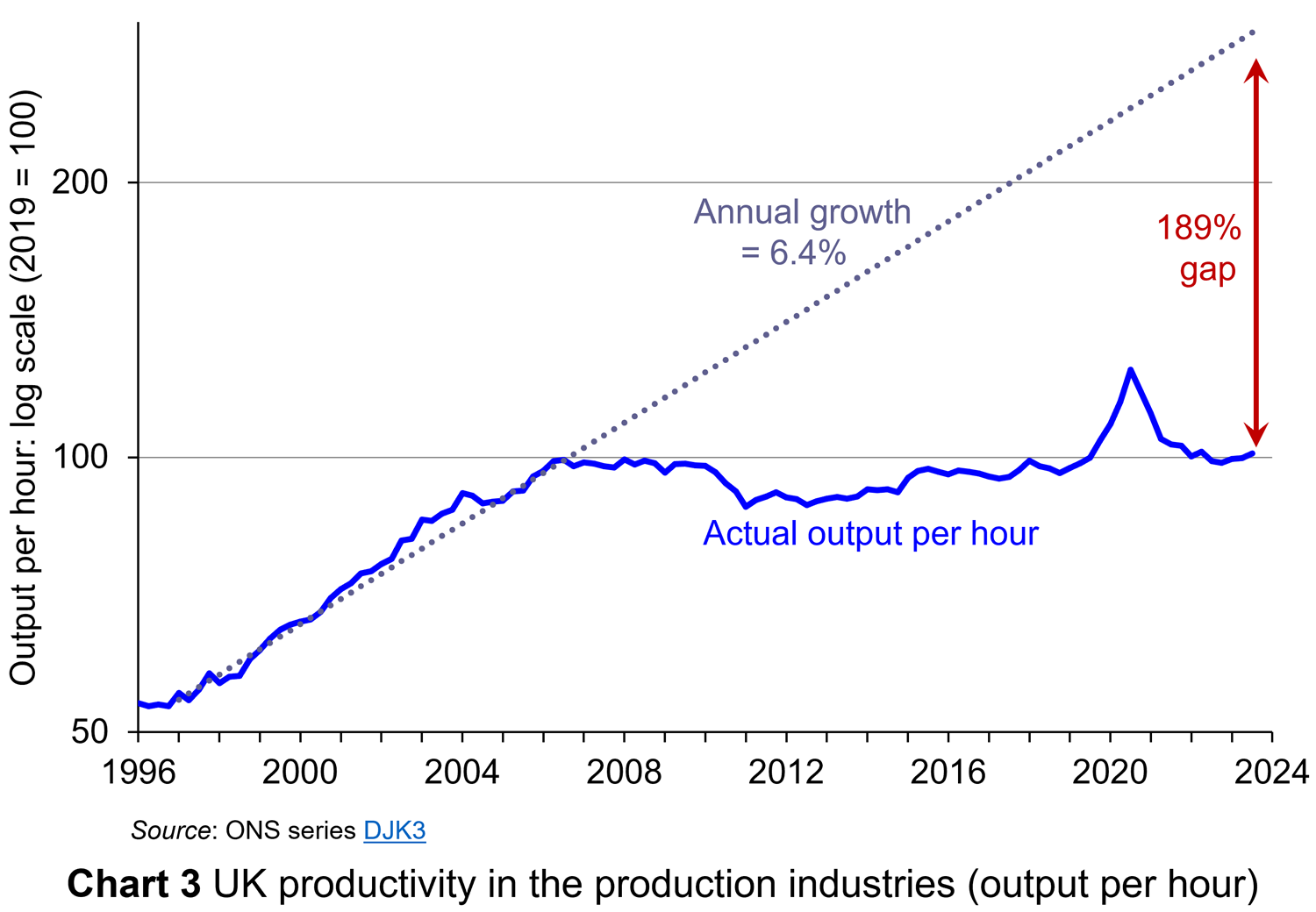 This is a key issue for the government – how to encourage a growth in productivity. The UK’s record of productivity growth has been poor since 2008. The period from 1996 to 2006 saw an average annual growth in labour productivity of 6.4%. Since then, however, labour productivity has grown by an average annual rate of only 0.3%. This is illustrated in Chart 3 (click here for a PowerPoint). If the pre-2007 rate had continued to the end of 2023, labour productivity would be 189% higher. This would have made GDP per head today substantially higher. If GDP per head is to grow faster, then the underlying issue of a poor growth in labour productivity will need to be addressed.
This is a key issue for the government – how to encourage a growth in productivity. The UK’s record of productivity growth has been poor since 2008. The period from 1996 to 2006 saw an average annual growth in labour productivity of 6.4%. Since then, however, labour productivity has grown by an average annual rate of only 0.3%. This is illustrated in Chart 3 (click here for a PowerPoint). If the pre-2007 rate had continued to the end of 2023, labour productivity would be 189% higher. This would have made GDP per head today substantially higher. If GDP per head is to grow faster, then the underlying issue of a poor growth in labour productivity will need to be addressed.
Inequality and poverty
Then there is the issue of the distribution of national income. The UK has a high level of income inequality. In 2022 (the latest data available), the disposable income of the poorest 20% of households was £13 218; that for the richest 20% was £83 687.  The top 1% of income earners’ share of disposable income is just under 9.0%. (Note that disposable income is after income taxes have been deducted and includes cash benefits and is thus more equally distributed than original income.)
The top 1% of income earners’ share of disposable income is just under 9.0%. (Note that disposable income is after income taxes have been deducted and includes cash benefits and is thus more equally distributed than original income.)
The poorest 20% have been hit badly by the cost-of-living crisis, with many having to turn to food banks and not being able to afford to heat their homes adequately. They are also particularly badly affected by the housing crisis, with soaring and increasingly unaffordable rents. Many are facing eviction and others live in poor quality accommodation. Simple growth rates in real GDP do not capture such issues.
Limited scope for growth policies
Fiscal policy has an important role in stimulating growth. Conservatives stress tax cuts as a means of incentivising entrepreneurs and workers. Labour stresses the importance of public investment in infrastructure, health, education and training. Either way, such stimulus policy requires financing.
 But, public finances have been under pressure in recent years, especially from COVID support measures. General government gross debt has risen from 27.7% of GDP in 1990/91 to 99.4% in 2022/23. This is illustrated in Chart 4 (click here for a PowerPoint). Although it has fallen from the peak of 107.6% of GDP in 2020/21 (during the COVID pandemic), according to the Office for Budget Responsibility it is set to rise again, peaking at 103.8% in 2026/27. There is thus pressure on the government to reduce public-sector borrowing, not increase it. This makes it difficult to finance public investment or tax cuts.
But, public finances have been under pressure in recent years, especially from COVID support measures. General government gross debt has risen from 27.7% of GDP in 1990/91 to 99.4% in 2022/23. This is illustrated in Chart 4 (click here for a PowerPoint). Although it has fallen from the peak of 107.6% of GDP in 2020/21 (during the COVID pandemic), according to the Office for Budget Responsibility it is set to rise again, peaking at 103.8% in 2026/27. There is thus pressure on the government to reduce public-sector borrowing, not increase it. This makes it difficult to finance public investment or tax cuts.
Measuring living standards
Questions about real GDP have huge political significance. Is the economy in recession? What will happen to growth in GDP over the coming months. Why has growth been sluggish in recent years? The implication is that if GDP rises, living standards will rise; if GDP falls, living standards will fall. But changes in GDP, even if expressed in terms of real GDP and even if the distribution of GDP is taken into account, are only a proxy for living standards. GDP measures the market value of the output of goods and services and, as such, may not necessarily be a good indicator of living standards, let alone well-being.
Produced goods and services that are not part of GDP
 The output of some goods and services goes unrecorded. As we note in Economics, 11e (section 15.2), “If you employ a decorator to paint your living room, this will be recorded in the GDP statistics. If, however, you paint the room yourself, it will not. Similarly, if a childminder is employed by parents to look after their children, this childcare will form part of GDP. If, however, a parent stays at home to look after the children, it will not.
The output of some goods and services goes unrecorded. As we note in Economics, 11e (section 15.2), “If you employ a decorator to paint your living room, this will be recorded in the GDP statistics. If, however, you paint the room yourself, it will not. Similarly, if a childminder is employed by parents to look after their children, this childcare will form part of GDP. If, however, a parent stays at home to look after the children, it will not.
The exclusion of these ‘do-it-yourself’ and other home-based activities means that the GDP statistics understate the true level of production in the economy. If over time there is an increase in the amount of do-it-yourself activities that people perform, the figures will also understate the rate of growth of national output.” With many people struggling with the cost of living, such a scenario is quite likely.
There are also activities that go unrecorded in the ‘underground’ or ‘shadow’ economy: unemployed people doing casual jobs for cash in hand that they do not declare to avoid losing benefits; people doing extra work outside their normal job and not declaring the income to evade taxes; builders doing work for cash to save the customer paying VAT.
Externalities
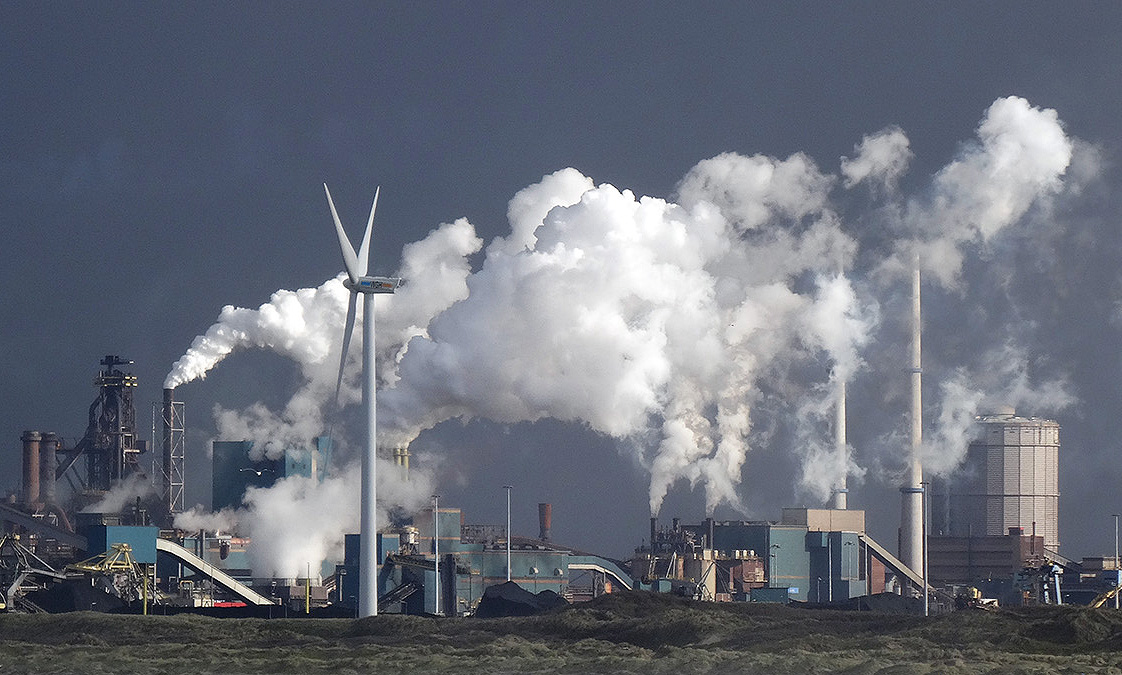 Large amounts of production and consumption involve external costs to the environment and to other people. These externalities are not included in the calculation of GDP.
Large amounts of production and consumption involve external costs to the environment and to other people. These externalities are not included in the calculation of GDP.
If external costs increase faster than GDP, then GDP growth will overstate the rise in living standards. If external costs rise more slowly than GDP (or even fall), then GDP growth will understate the rise in living standards. We assume here that living standards include social and environmental benefits and are reduced by social and environmental costs.
Human costs of production
If production increases as a result of people having to work harder or longer hours, its net benefit will be less. Leisure is a desirable good, and so too are pleasant working conditions, but these items are not included in the GDP figures.
The production of certain ‘bads’ leads to an increase in GDP
 Some of the undesirable effects of growth may in fact increase GDP! Take the examples of crime, stress-related illness and environmental damage. Faster growth may lead to more of all three. But increased crime leads to more expenditure on security; increased stress leads to more expenditure on health care; and increased environmental damage leads to more expenditure on environmental clean-up. These expenditures add to GDP. Thus, rather than reducing GDP, crime, stress and environmental damage actually increase it.
Some of the undesirable effects of growth may in fact increase GDP! Take the examples of crime, stress-related illness and environmental damage. Faster growth may lead to more of all three. But increased crime leads to more expenditure on security; increased stress leads to more expenditure on health care; and increased environmental damage leads to more expenditure on environmental clean-up. These expenditures add to GDP. Thus, rather than reducing GDP, crime, stress and environmental damage actually increase it.
Alternative approaches to measuring production and income
There have been various attempts to adjust GDP (actual or potential) to make it a better indicator of total production or income or, more generally, of living standards.
Index of Sustainable Economic Welfare (ISEW)
As Case Study 9.20 in the Essentials of Economics (9e) website explains, ISEW starts with consumption, as measured in GDP, and then makes various adjustments to account for factors that GDP ignores. These include:
- Inequality: the greater the inequality, the more the figure for consumption is reduced. This is based on the assumption of a diminishing marginal utility of income, such that an additional pound is worth less to a rich person than to a poor person.
- Household production (such as childcare, care for the elderly or infirm, housework and various do-it-yourself activities). These ‘services of household labour’ add to welfare and are thus entered as a positive figure.
- Defensive expenditures. This is spending to offset the adverse environmental effects of economic growth (e.g. asthma treatment for sufferers whose condition arises from air pollution). Such expenditures are taken out of the calculations.
- ‘Bads’ (such as commuting costs). The monetary expense entailed is entered as a negative figure (to cancel out its measurement in GDP as a positive figure) and then an additional negative element is included for the stress incurred.
- Environmental costs. Pollution is entered as a negative figure.
- Resource depletion and damage. This too is given a negative figure, in just the same way that depreciation of capital is given a negative figure when working out net national income.
Productive Capacities Index (PCI)
In 2023, the United Nations Conference on Trade and Development (UNCTAD) launched a new index to provide a better measure of countries’ economic potential. What the index focuses on is not actual GDP but potential output: in other words, ‘countries’ abilities to produce goods and deliver services’.
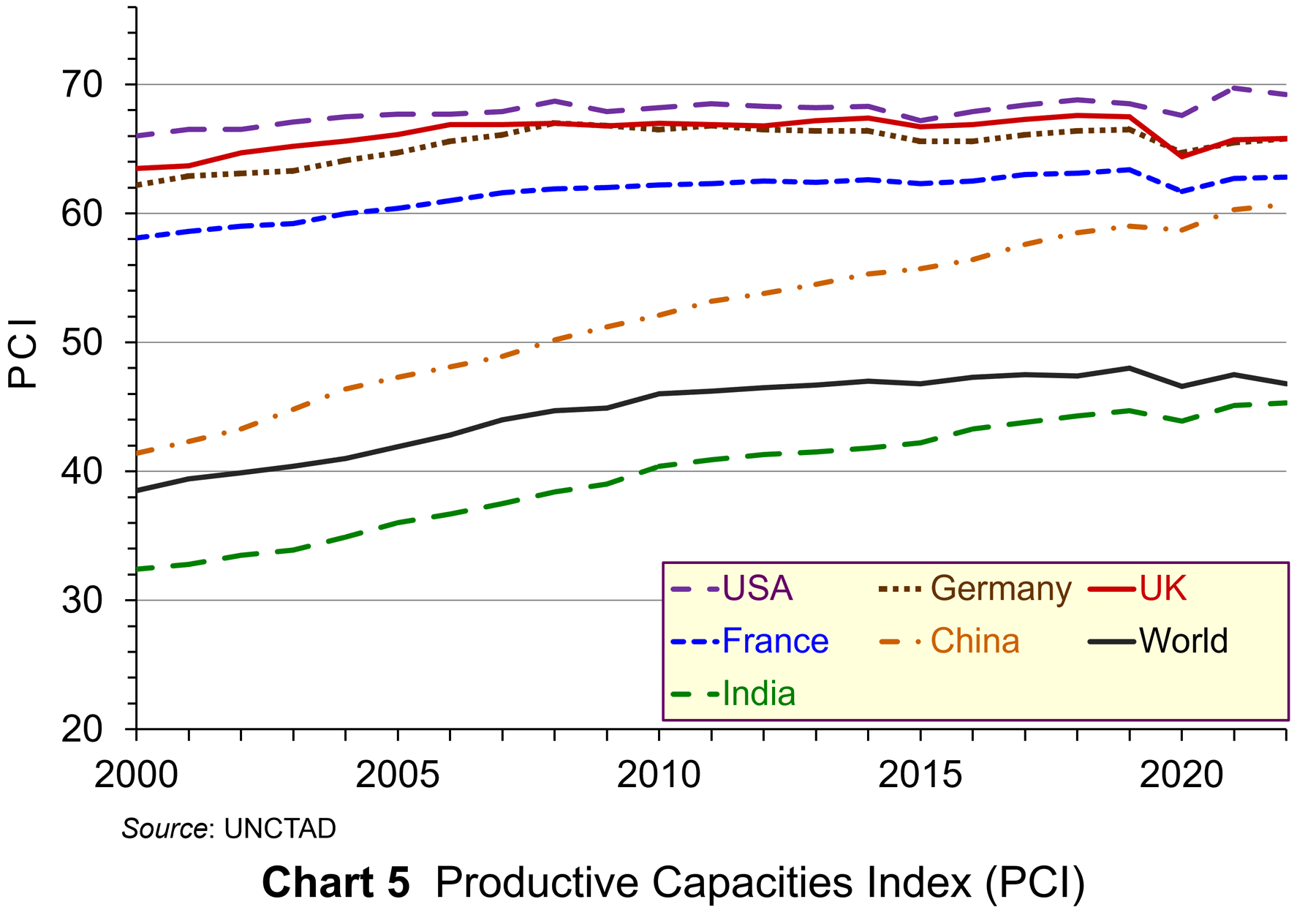 The PCI comprises 42 indicators under eight headings: human capital, natural capital, information and communication technology (ICT), structural change (the movement of labour and other productive resources from low-productivity to high-productivity economic activities), transport infrastructure, institutions (political, legal and financial) and the private sector (ease of starting businesses, availability of credit, ease of cross-border trade, etc.). It covers 194 economies since 2000 (currently to 2022). As UNCTAD states, ‘The PCI can help diagnose the areas where countries may be leading or falling behind, spotlighting where policies are working and where corrective efforts are needed.’ Chart 5 shows the PCI for various economies from 2000 to 2022 (click here for a PowerPoint).
The PCI comprises 42 indicators under eight headings: human capital, natural capital, information and communication technology (ICT), structural change (the movement of labour and other productive resources from low-productivity to high-productivity economic activities), transport infrastructure, institutions (political, legal and financial) and the private sector (ease of starting businesses, availability of credit, ease of cross-border trade, etc.). It covers 194 economies since 2000 (currently to 2022). As UNCTAD states, ‘The PCI can help diagnose the areas where countries may be leading or falling behind, spotlighting where policies are working and where corrective efforts are needed.’ Chart 5 shows the PCI for various economies from 2000 to 2022 (click here for a PowerPoint).
The UK, with a PCI of 65.8 in 2022, compares relatively favourably with other developed countries. The USA’s PCI is somewhat higher (69.2), as is The Netherlands’ (69.8); Germany’s is the same (65.8); France’s is somewhat lower (62.8). The world average is 46.8. For developing countries, China is relatively high (60.7); India’s (45.3) is close to the developing country average of 43.4.
Looked at over a longer time period, the UK’s performance is relatively weak. The PCI in 2022 (65.8) was below that in 2006 (66.9) and below the peak of 67.6 in 2018.
GDP and well-being
GDP is often used as a proxy for well-being. If real GDP per head increases, then it is assumed that well-being will increase. In practice, people’s well-being depends on many factors, not just their income, although income is one important element.
The UK Measuring National Well-being (MNW) programme
 The MNW programme was established in 2010. This has resulted in Office for National Statistics developing new measures of national well-being. The ONS produces statistical bulletins and datasets with its latest results.
The MNW programme was established in 2010. This has resulted in Office for National Statistics developing new measures of national well-being. The ONS produces statistical bulletins and datasets with its latest results.
The aim of the programme is to provide a ‘fuller picture’ of how society is doing beyond traditional economic indicators. There are currently 44 indicators. These are designed to describe ‘how we are doing as individuals, as communities and as a nation, and how sustainable this is for the future’. The measures fall within a number of categories, including: personal well-being, relationships, health, what we do, where we live, personal finance, the economy, education and skills, governance and the natural environment.
Conclusions
In the light of the limitations of GDP as a measure of living standards, what can we make of the news that the UK entered recession in the last half of 2023? It does show that the economy is sluggish and that the production of goods and services that are included in the GDP measure declined.
But to get a fuller assessment of the economy, it is important to take a number of other factors into account. If we are to go further and ask what has happened to living standards or to well-being, then we have to look at a range of other factors. If we are to ask what the latest figures tell us about what is likely to happen in the future to production, living standards and well-being, then we will need to look further still.
Articles
- Britain falls into recession, with worst GDP performance in 2023 in years
CNN, Hanna Ziady (15/2/24)
- UK economy slipped into recession in 2023
Financial Times, Valentina Romei and George Parker (15/2/24)
- UK economy fell into recession after people cut spending
BBC News, Dearbail Jordan & Faisal Islam (15/2/24)
- Should we care that the UK is in recession?
BBC News, Faisal Islam (15/2/24)
- UK tips into recession in blow to Rishi Sunak
The Guardian, Richard Partington (15/2/24)
- Britain is in recession… and huge immigration has been masking how much poorer we’re getting
MSN, James Tapsfield (15/2/24)
- This isn’t a “mild” recession
The New Statesman, Duncan Weldon (15/2/24)
- UK middle classes ‘struggling despite incomes of up to £60,000 a year’
The Guardian, Larry Elliott (20/2/24)
- What is GDP and how is it measured?
BBC News (15/2/24)
 World at One (from 7’00” to 25’14”)
World at One (from 7’00” to 25’14”)BBC Sounds, Torsten Bell and Norman Lamont (15/2/24)
- Does High GDP Mean Economic Prosperity?
Investopedia, Lisa Smith (29/9/23)
- A critical assessment of GDP as a measure of economic performance and social progress
Carnegie UK, Cressida Gaukroger (June 2023)
- When it comes to measuring economic welfare, GDP doesn’t cut it
Marketplace, Kai Ryssdal and Maria Hollenhorst (1/9/23)
- UNCTAD launches new index for countries to better measure economic potential
UNCTAD News (20/6/23)
- Redefining Economic Growth for a Climate-Conscious World
Forbes, Judah Taub (28/9/23)
- Bobby Kennedy on GDP: ‘measures everything except that which is worthwhile’
The Guardian, Simon Rogers (24/5/12)
- A guide to the UK National Accounts: Satellite Accounts
ONS (6/3/20)
Data and Analysis
- GDP first quarterly estimate, UK: October to December 2023
ONS (15/2/24)
- GDP (Average) per head, q-on-q4 growth rate CVM SA % (series N3Y8)
ONS
- Gross domestic product (Average) per head, CVM market prices: SA (series IHXW)
ONS
- GDP per capita, current prices (UK)
IMF
- Productive capacities index, annual, 2000-2022
UNCTAD
- The Scale of Economic Inequality in the UK
The Equality Trust (2023)
- Living standards, poverty and inequality in the UK: 2023
IFS, Sam Ray-Chaudhuri, Tom Waters, Thomas Wernham and Xiaowei Xu (July 2023)
- Quarterly personal well-being estimates – seasonally adjusted
ONS
Questions
- Using GDP and other data, summarise the outlook for the UK economy.
- Why is GDP so widely used as an indicator of living standards?
- Explain the three methods of measuring GDP?
- What key contributors to living standards are omitted from GDP?
- What are the ONS Satellite Accounts? Are they useful for measuring living standards?
- Assess the UK’s economic potential against each of the eight category indices in the Productive Capacities Index.
- What is the difference between ‘living standards’ and ‘well-being’?
 Since 2019, UK personal taxes (income tax and national insurance) have been increasing as a proportion of incomes and total tax revenues have been increasing as a proportion of GDP. However, in his Autumn Statement of 22 November, the Chancellor, Jeremy Hunt, announced a 2 percentage point cut in the national insurance rate for employees from 12% to 10%. The government hailed this as a significant tax cut. But, despite this, taxes are set to continue increasing. According to the Office for Budget Responsibility (OBR), from 2019/20 to 2028/29, taxes will have increased by 4.5 per cent of GDP (see chart below), raising an extra £44.6 billion per year by 2028/29. One third of this is the result of ‘fiscal drag’ from the freezing of tax thresholds.
Since 2019, UK personal taxes (income tax and national insurance) have been increasing as a proportion of incomes and total tax revenues have been increasing as a proportion of GDP. However, in his Autumn Statement of 22 November, the Chancellor, Jeremy Hunt, announced a 2 percentage point cut in the national insurance rate for employees from 12% to 10%. The government hailed this as a significant tax cut. But, despite this, taxes are set to continue increasing. According to the Office for Budget Responsibility (OBR), from 2019/20 to 2028/29, taxes will have increased by 4.5 per cent of GDP (see chart below), raising an extra £44.6 billion per year by 2028/29. One third of this is the result of ‘fiscal drag’ from the freezing of tax thresholds.
According to the OBR
Fiscal drag is the process by which faster growth in earnings than in income tax thresholds results in more people being subject to income tax and more of their income being subject to higher tax rates, both of which raise the average tax rate on total incomes.
Income tax thresholds have been unchanged for the past three years and the current plan is that they will remain frozen until at least 2027/28. This is illustrated in the following table.

If there were no inflation, fiscal drag would still apply if real incomes rose. In other words, people would be paying a higher average rate of tax. Part of the reason is that some people on low incomes would be dragged into paying tax for the first time and more people would be paying taxes at higher rates. Even in the case of people whose income rise did not pull them into a higher tax bracket (i.e. they were paying the same marginal rate of tax), they would still be paying a higher average rate of tax as the personal allowance would account for a smaller proportion of their income.
Inflation compounds this effect. Tax bands are in nominal not real terms. Assume that real incomes stay the same and that tax bands are frozen. Nominal incomes will rise by the rate of inflation and thus fiscal drag will occur: the real value of the personal allowance will fall and a higher proportion of incomes will be paid at higher rates. Since 2021, some 2.2 million workers, who previously paid no income taxes as their incomes were below the personal allowance, are now paying tax on some of their wages at the 20% rate. A further 1.6 million workers have moved to the higher tax bracket with a marginal rate of 40%.
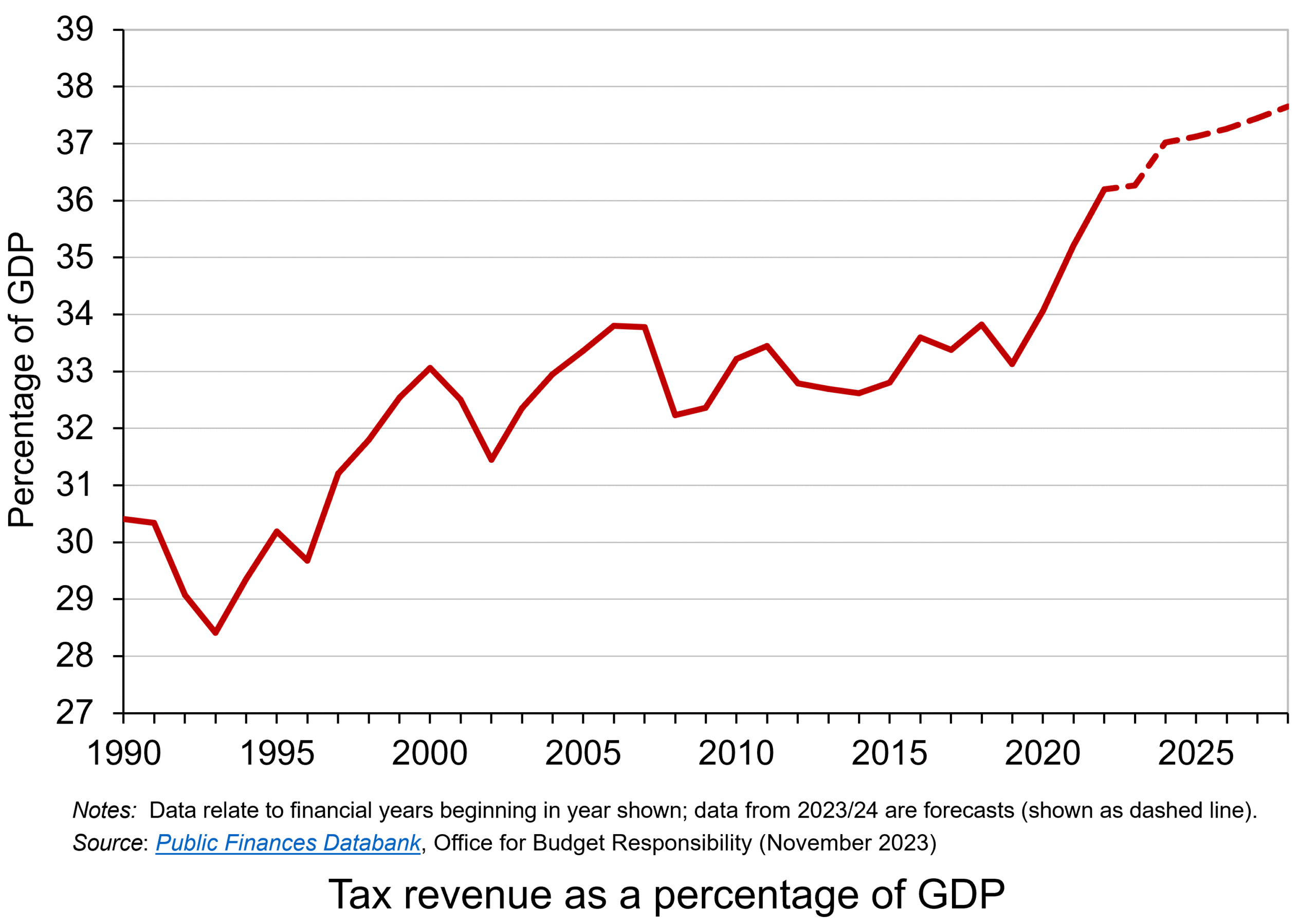 The net effect is that, although national insurance rates have been cut by 2 percentage points, the tax burden will continue rising. The OBR estimates that by 2027/28, tax revenues will be 37.4% of GDP; they were 33.1% in 2019/20. This is illustrated in the chart (click here for a PowerPoint).
The net effect is that, although national insurance rates have been cut by 2 percentage points, the tax burden will continue rising. The OBR estimates that by 2027/28, tax revenues will be 37.4% of GDP; they were 33.1% in 2019/20. This is illustrated in the chart (click here for a PowerPoint).
Much of this rise will be the result of fiscal drag. According to the OBR, fiscal drag from freezing personal allowances, even after the cut in national insurance rates, will raise an extra £42.9 billion per year by 2027/28. This would be equivalent of the amount raised by a rise in national insurance rates of 10 percentage points. By comparison, the total cost to the government of the furlough scheme during the pandemic was £70 billion. For further analysis by the OBR of the magnitude of fiscal drag, see Box 3.1 (p 69) in the November 2023 edition of its Economic and fiscal outlook.
Political choices
 Support measures during the pandemic and its aftermath and subsidies for energy bills have led to a rise in government debt. This has put a burden on public finances, compounded by sluggish growth and higher interest rates increasing the cost of servicing government debt. This leaves the government (and future governments) in a dilemma. It must either allow fiscal drag to take place by not raising allowances or even raise tax rates, cut government expenditure or increase borrowing; or it must try to stimulate economic growth to provide a larger tax base; or it must do some combination of all of these. These are not easy choices. Higher economic growth would be the best solution for the government, but it is difficult for governments to achieve. Spending on infrastructure, which would support growth, is planned to be cut in an attempt to reduce borrowing. According to the OBR, under current government plans, public-sector net investment is set to decline from 2.6% of GDP in 2023/24 to 1.8% by 2028/29.
Support measures during the pandemic and its aftermath and subsidies for energy bills have led to a rise in government debt. This has put a burden on public finances, compounded by sluggish growth and higher interest rates increasing the cost of servicing government debt. This leaves the government (and future governments) in a dilemma. It must either allow fiscal drag to take place by not raising allowances or even raise tax rates, cut government expenditure or increase borrowing; or it must try to stimulate economic growth to provide a larger tax base; or it must do some combination of all of these. These are not easy choices. Higher economic growth would be the best solution for the government, but it is difficult for governments to achieve. Spending on infrastructure, which would support growth, is planned to be cut in an attempt to reduce borrowing. According to the OBR, under current government plans, public-sector net investment is set to decline from 2.6% of GDP in 2023/24 to 1.8% by 2028/29.
The government is attempting to achieve growth by market-orientated supply-side measures, such as making permanent the current 100% corporation tax allowance for investment. Other measures include streamlining the planning system for commercial projects, a business rates support package for small businesses and targeted government support for specific sectors, such as digital technology. Critics argue that this will not be sufficient to offset the decline in public investment and renew crumbling infrastructure.
To support public finances, the government is using a combination of higher taxation, largely through fiscal drag, and cuts in government expenditure (from 44.8% of GDP in 2023/24 to a planned 42.7% by 2028/29). If the government succeeds in doing this, the OBR forecasts that public-sector net borrowing will fall from 4.5% of GDP in 2023/24 to 1.1% by 2028/29. But higher taxes and squeezed public expenditure will make many people feel worse off, especially those that rely on public services.
Videos
 Fiscal drag
Fiscal dragSky News Politics Hub on X, Sophy Ridge (22/11/23)
 Fiscal drag
Fiscal dragSky News Politics Hub on X, Beth Rigby (22/11/23)
Articles
- Autumn Statement 2023 response
IFS, Stuart Adam, Bee Boileau, Isaac Delestre, Carl Emmerson, Paul Johnson, Robert Joyce, Martin Mikloš, Helen Miller, David Phillips, Sam Ray-Chaudhuri, Isabel Stockton Tom Waters, Tom Wernham and Ben Zaranko (22/11/23)
- Autumn Statement: Jeremy Hunt cuts National Insurance but tax burden still rises
BBC News, Brian Wheeler (23/11/23)
- The hidden tax rise in the Autumn Statement
BBC News, Michael Race (23/11/23)
- How is National Insurance changing and what is income tax?
BBC News (23/11/23)
- UK income tax: how fiscal drag leads to people falling into higher rates
The Guardian, Antonio Voce and Ashley Kirk (22/11/23)
- Will I be pulled into a higher tax band? How ‘fiscal drag’ affects your pay
i News, Alex Dakers (23/11/23)
- Fiscal drag could cost high earners £4,000 by 2027
MoneyWeek, Marc Shoffman (16/11/23)
- Why the UK government’s tax cuts still leave workers worse off
CNBC, Elliot Smith (23/11/23)
- National insurance cuts swamped by stealth tax rise, says fiscal watchdog
Financial Times, Emma Agyemang (22/11/23)
- Frozen income tax bands eat into benefits of NI cut, say experts
FT Adviser, Tara O’Connor (23/11/23)
- Jeremy Hunt’s fiscal fudge
Financial Times editorial (22/11/23)
Report and data from the OBR
Questions
- Would fiscal drag occur with frozen nominal tax bands if there were zero real growth in incomes? Explain.
- Examine the arguments for continuing to borrow to fund a Budget deficit over a number of years.
- When interest rates rise, how much does this affect the cost of servicing public-sector debt? Why is the effect likely to be greater in the long run than in the short run?
- If the government decides that it wishes to increase tax revenues as a proportion of GDP (for example, to fund increased government expenditure on infrastructure and socially desirable projects and benefits), examine the arguments for increasing personal allowances and tax bands in line with inflation but raising the rates of income tax in order to raise sufficient revenue?
- Distinguish between market-orientated and interventionist supply-side policies? Why do political parties differ in their approaches to supply-side policy?
 China has been an economic powerhouse in recent decades – a powerhouse that has helped to drive the world economy through trade and both inward and outward investment. At the same time, its low-priced exports have helped to dampen world inflation. But is all this changing? Is China, to use President Biden’s words, a ‘ticking time bomb’?
China has been an economic powerhouse in recent decades – a powerhouse that has helped to drive the world economy through trade and both inward and outward investment. At the same time, its low-priced exports have helped to dampen world inflation. But is all this changing? Is China, to use President Biden’s words, a ‘ticking time bomb’?
China’s economic growth rate is slowing, with the quarterly growth in GDP falling from 2.2% in Q1 this year to 0.8% in Q2. Even though public-sector investment rose by 8.1% in the first six months of this year, private-sector investment fell by 0.2%, reflecting waning business confidence. And manufacturing output declined in August. But, despite slowing growth, the Chinese government is unlikely to use expansionary fiscal policy because of worries about growing public-sector debt.
The property market
 One of the biggest worries for the Chinese economy is the property market. The annual rate of property investment fell by 20.6% in June this year and new home prices fell by 0.2% in July (compared with June). The annual rate of price increase for new homes was negative throughout 2022, being as low as minus 1.6% in November 2022; it was minus 0.1% in the year to July 2023, putting new-home prices at 2.4% below their August 2021 level. However, these are official statistics. According to the Japan Times article linked below, which reports Bloomberg evidence, property agents and private data providers report much bigger falls, with existing home prices falling by at least 15% in many cities.
One of the biggest worries for the Chinese economy is the property market. The annual rate of property investment fell by 20.6% in June this year and new home prices fell by 0.2% in July (compared with June). The annual rate of price increase for new homes was negative throughout 2022, being as low as minus 1.6% in November 2022; it was minus 0.1% in the year to July 2023, putting new-home prices at 2.4% below their August 2021 level. However, these are official statistics. According to the Japan Times article linked below, which reports Bloomberg evidence, property agents and private data providers report much bigger falls, with existing home prices falling by at least 15% in many cities.
Falling home prices have made home-owners poorer and this wealth effect acts as a brake on spending. The result is that, unlike in many Western countries, there has been no post-pandemic bounce back in spending. There has also been a dampening effect on local authority spending. During the property boom they financed a proportion of their spending by selling land to property developers. That source of revenue has now largely dried up. And as public-sector revenues have been constrained, so this has constrained infrastructure spending – a major source of growth in China.
The government, however, has been unwilling to compensate for this by encouraging private investment and has tightened regulation of the financial sector. The result has been a decline in new jobs and a rise in unemployment, especially among graduates, where new white collar jobs in urban areas are declining. According to the BBC News article linked below, “In July, figures showed a record 21.3% of jobseekers between the ages of 16 and 25 were out of work”.
Deflation
 The fall in demand has caused consumer prices to fall. In the year to July 2023, they fell by 0.3%. Even though core inflation is still positive (0.8%), the likelihood of price reductions in the near future discourages spending as people hold back, waiting for prices to fall further. This further dampens the economy. This is a problem that was experienced in Japan over many years.
The fall in demand has caused consumer prices to fall. In the year to July 2023, they fell by 0.3%. Even though core inflation is still positive (0.8%), the likelihood of price reductions in the near future discourages spending as people hold back, waiting for prices to fall further. This further dampens the economy. This is a problem that was experienced in Japan over many years.
Despite slowing economic growth, Chinese annual growth in GDP for 2023 is still expected to be around 4.5% – much lower than the average rate for 9.5% from 1991 to 2019, but considerably higher than the average of 1.1% forecast for 2023 for the G7 countries. Nevertheless, China’s exports fell by 14.5% in the year to July 2023 and imports fell by 12.5%. The fall in imports represents a fall in exports to China from the rest of the world and hence a fall in injections to the rest-of-the-world economy. Currently China’s role as a powerhouse of the world has gone into reverse.
Articles
Questions
- Using PowerPoint or Excel, plot the growth rate of Chinese real GDP, real exports and real imports from 1990 to 2024 (using forecasts for 2023 and 2024). Use data from the IMF’s World Economic Outlook database. Comment on the figures.
- Explain the wealth effect from falling home prices.
- Why may official figures understate the magnitude of home price deflation?
- Explain the foreign trade multiplier and its relevance to other countries when the volume of Chinese imports changes. What determines the size of this multiplier for a specific country?
- How does the nature of the political system in China affect the likely policy response to the problems identified in this blog?
- Is there any good news for the rest of the world from the slowdown in the Chinese economy?
 The UK Chancellor of the Exchequer, Rachel Reeves, will present her annual Budget in late autumn. It will involve some hard economic and political choices. The government would like to spend more money on improving public services but has pledged not to raise taxes ‘on working people’, which is interpreted as not raising the rates of income tax, national insurance for employees and the self-employed, and VAT. What is more, government borrowing is forecast by the OBR to be £118 billion, or nearly 4.0% of GDP, for the the year 2025/26. This is a fall from the 5.1% in 2024/25 and is well below the 15.0% in 2020/21 during the pandemic. But it is significantly above the 2.1% in 2018/19.
The UK Chancellor of the Exchequer, Rachel Reeves, will present her annual Budget in late autumn. It will involve some hard economic and political choices. The government would like to spend more money on improving public services but has pledged not to raise taxes ‘on working people’, which is interpreted as not raising the rates of income tax, national insurance for employees and the self-employed, and VAT. What is more, government borrowing is forecast by the OBR to be £118 billion, or nearly 4.0% of GDP, for the the year 2025/26. This is a fall from the 5.1% in 2024/25 and is well below the 15.0% in 2020/21 during the pandemic. But it is significantly above the 2.1% in 2018/19. The government has pledged to stick to its two fiscal rules. The first is that the day-to-day, or ‘current’, budget (i.e. excluding investment) should be in surplus or in deficit of no more than 0.5 per cent of GDP by 2029/30 (or the third year of the rolling forecast period from the 2026/27 Budget). This allows investment to be funded by borrowing. The second rule is that public-sector net debt, which includes public-sector debt plus pension liabilities minus equity, loans and other financial assets, should be falling by 2029/30 (or the third year of the rolling forecast period from the 2026/27 Budget). The current budget deficit (i.e. excluding borrowing for investment) was forecast by the OBR in March to be 1.2% of GDP for 2025/26 (see Chart 1) and to be a surplus of 0.3% in 2029/30 (£9.9 billion). (Click here for a PowerPoint of the chart.)
The government has pledged to stick to its two fiscal rules. The first is that the day-to-day, or ‘current’, budget (i.e. excluding investment) should be in surplus or in deficit of no more than 0.5 per cent of GDP by 2029/30 (or the third year of the rolling forecast period from the 2026/27 Budget). This allows investment to be funded by borrowing. The second rule is that public-sector net debt, which includes public-sector debt plus pension liabilities minus equity, loans and other financial assets, should be falling by 2029/30 (or the third year of the rolling forecast period from the 2026/27 Budget). The current budget deficit (i.e. excluding borrowing for investment) was forecast by the OBR in March to be 1.2% of GDP for 2025/26 (see Chart 1) and to be a surplus of 0.3% in 2029/30 (£9.9 billion). (Click here for a PowerPoint of the chart.) A forecast earlier this month by the National Institute for Economic and Social Research (NIESR) (see link below and Chart 2) reflects these problems and paints a gloomier picture than the OBR’s March forecast. The NIESR forecasts that GDP will grow by only 1.3 per cent in 2025, 1.2 per cent in 2026, 1.1% in 2027 and 1.0% in 2028, with the average for 2025 to 2023 being 1.13%. This is the result of high levels of business uncertainty and the effects of tariffs on exports. With no change in policy, the current deficit would be £41.2 billion in the 2029/30 financial year. Inflation would fall somewhat, but would stick at around 2.7% from 2028 to 2030. Net debt would be rising in 2029/30 &ndash but only slightly, from 98.7% to 99.0%. (Click here for a PowerPoint of the chart.)
A forecast earlier this month by the National Institute for Economic and Social Research (NIESR) (see link below and Chart 2) reflects these problems and paints a gloomier picture than the OBR’s March forecast. The NIESR forecasts that GDP will grow by only 1.3 per cent in 2025, 1.2 per cent in 2026, 1.1% in 2027 and 1.0% in 2028, with the average for 2025 to 2023 being 1.13%. This is the result of high levels of business uncertainty and the effects of tariffs on exports. With no change in policy, the current deficit would be £41.2 billion in the 2029/30 financial year. Inflation would fall somewhat, but would stick at around 2.7% from 2028 to 2030. Net debt would be rising in 2029/30 &ndash but only slightly, from 98.7% to 99.0%. (Click here for a PowerPoint of the chart.) The second problem is that the Chancellor has said that she will stick to the fiscal rules. If she scraps them, if only temporarily, she runs the risk of losing the confidence of investors. This could lead to a run on the pound and even higher interest rates. This was a problem under the short-lived Liz Truss government when the ‘mini’ Budget of September 2022 made unfunded pledges to cut taxes. There was a run on the pound and the Bank of England had to make emergency gilt purchases.
The second problem is that the Chancellor has said that she will stick to the fiscal rules. If she scraps them, if only temporarily, she runs the risk of losing the confidence of investors. This could lead to a run on the pound and even higher interest rates. This was a problem under the short-lived Liz Truss government when the ‘mini’ Budget of September 2022 made unfunded pledges to cut taxes. There was a run on the pound and the Bank of England had to make emergency gilt purchases. The current government has launched a Public Sector Productivity Programme. This is a a cross-government initiative to improve productivity across public services. Departments are required to develop productivity plans to invest in schemes designed to achieve cost savings and improve outcomes in areas such as the NHS, police, and justice system. A £1.8 billion fund was announced in March 2024, to support public-sector productivity improvements and digital transformation. Part of this is to be invested in digital services and AI to improve efficiency. According to the ONS, total public-service productivity in the UK grew by 1.0% in the year to Q1 2025; healthcare productivity grew 2.7% over the same period. It remains to be seen whether this growth in productivity will be maintained. Pressure from the public, however, will mean that any gains are likely to be in terms of improved services rather than reduced government expenditure.
The current government has launched a Public Sector Productivity Programme. This is a a cross-government initiative to improve productivity across public services. Departments are required to develop productivity plans to invest in schemes designed to achieve cost savings and improve outcomes in areas such as the NHS, police, and justice system. A £1.8 billion fund was announced in March 2024, to support public-sector productivity improvements and digital transformation. Part of this is to be invested in digital services and AI to improve efficiency. According to the ONS, total public-service productivity in the UK grew by 1.0% in the year to Q1 2025; healthcare productivity grew 2.7% over the same period. It remains to be seen whether this growth in productivity will be maintained. Pressure from the public, however, will mean that any gains are likely to be in terms of improved services rather than reduced government expenditure. Cutting tax relief for pensions. Currently, people get income tax relief at their marginal rate on pension contributions made by themselves and their employer up to £60 000 per year or 100% of their earnings, whichever is smaller. When people draw on their pension savings, they pay income tax at their marginal rate, even if the size of their savings has grown from capital gains, interest or dividends. Reducing the limits or restricting relief to the basic rate of tax could make a substantial contribution to increasing government revenue. In 2023/24, pension contribution relief cost the government £52 billion. Restricting relief to the basic rate or cutting the annual limit would make the relief less regressive. In such a case, when people draw on their pension savings, the income tax rate could be limited to the basic rate to avoid double taxation.
Cutting tax relief for pensions. Currently, people get income tax relief at their marginal rate on pension contributions made by themselves and their employer up to £60 000 per year or 100% of their earnings, whichever is smaller. When people draw on their pension savings, they pay income tax at their marginal rate, even if the size of their savings has grown from capital gains, interest or dividends. Reducing the limits or restricting relief to the basic rate of tax could make a substantial contribution to increasing government revenue. In 2023/24, pension contribution relief cost the government £52 billion. Restricting relief to the basic rate or cutting the annual limit would make the relief less regressive. In such a case, when people draw on their pension savings, the income tax rate could be limited to the basic rate to avoid double taxation. Raise fuel and/or other duties. Fuel duties raise approximately £24 billion. They are set to decline gradually with the shift to EVs and more fuel-efficient internal combustion engines. Fuel duty remained unchanged at 57.95p per litre from 2011 to 2022 and then was ‘temporarily’ cut to 52.95p. The rate of 52.95p is set to remain until at least 2026. There is clearly scope here to raise it, if only by the rate of inflation each year. Again, the main problem is a political one that drivers and the motor lobby generally will complain. Other duties include alcohol, tobacco/cigarettes/vaping, high-sugar beverages and gambling. Again, there is scope for raising these. There are two problems here. The first is that these duties are regressive, falling more heavily on poorer people. The second is that high duties can encourage illegal trade in these products.
Raise fuel and/or other duties. Fuel duties raise approximately £24 billion. They are set to decline gradually with the shift to EVs and more fuel-efficient internal combustion engines. Fuel duty remained unchanged at 57.95p per litre from 2011 to 2022 and then was ‘temporarily’ cut to 52.95p. The rate of 52.95p is set to remain until at least 2026. There is clearly scope here to raise it, if only by the rate of inflation each year. Again, the main problem is a political one that drivers and the motor lobby generally will complain. Other duties include alcohol, tobacco/cigarettes/vaping, high-sugar beverages and gambling. Again, there is scope for raising these. There are two problems here. The first is that these duties are regressive, falling more heavily on poorer people. The second is that high duties can encourage illegal trade in these products. The UK Chancellor of the Exchequer, Jeremy Hunt, delivered his Spring Budget on 6 March 2024. In his speech, he announced a cut in national insurance (NI): a tax paid by workers on employment or self-employment income. The main rate of NI for employed workers will be cut from 10% to 8% from 6 April 2024. This follows a cut this January from 12% to 10%. The rate for the self-employed will be cut from 9% to 6% from 6 April. These will be the new marginal rates from the NI-free threshold of £12 750 to the higher threshold of £50 270 (above which the marginal rate is 2% and remains unchanged). Unlike income tax, NI applies only to income from work (employment or self-employment) and does not include pension incomes, rent, interest and dividends.
The UK Chancellor of the Exchequer, Jeremy Hunt, delivered his Spring Budget on 6 March 2024. In his speech, he announced a cut in national insurance (NI): a tax paid by workers on employment or self-employment income. The main rate of NI for employed workers will be cut from 10% to 8% from 6 April 2024. This follows a cut this January from 12% to 10%. The rate for the self-employed will be cut from 9% to 6% from 6 April. These will be the new marginal rates from the NI-free threshold of £12 750 to the higher threshold of £50 270 (above which the marginal rate is 2% and remains unchanged). Unlike income tax, NI applies only to income from work (employment or self-employment) and does not include pension incomes, rent, interest and dividends.
 Tax revenues are still set to rise as a percentage of GDP. This is illustrated in the chart. Tax revenues were 33.2% of GDP in 2010/11. By 2022/23 the figure had risen to 36.3%. With neither of the two changes to NI (January 2024 and April 2024), the OBR forecasts that the figure would rise to 37.7% by 2028/29 – the top dashed line in the chart. After the first cut, announced in November, it forecasts a smaller rise to 37.3% – the middle dashed line. After the second cut, announced in the Spring Budget, the OBR cut the forecast figure to 37.1% – the bottom dashed line. (Click
Tax revenues are still set to rise as a percentage of GDP. This is illustrated in the chart. Tax revenues were 33.2% of GDP in 2010/11. By 2022/23 the figure had risen to 36.3%. With neither of the two changes to NI (January 2024 and April 2024), the OBR forecasts that the figure would rise to 37.7% by 2028/29 – the top dashed line in the chart. After the first cut, announced in November, it forecasts a smaller rise to 37.3% – the middle dashed line. After the second cut, announced in the Spring Budget, the OBR cut the forecast figure to 37.1% – the bottom dashed line. (Click 
 For 2023 as a whole, while real GDP rose by 0.20%, real GDP per head fell by 0.67%. In the last two quarters of 2023, while real GDP fell by 0.1% and 0.3% respectively, real GDP per head fell by 0.4% and 0.6%, respectively, having already fallen in each of the previous five quarters. Chart 1 shows real GDP growth and real GDP growth per head from 2007 to 2023 (click
For 2023 as a whole, while real GDP rose by 0.20%, real GDP per head fell by 0.67%. In the last two quarters of 2023, while real GDP fell by 0.1% and 0.3% respectively, real GDP per head fell by 0.4% and 0.6%, respectively, having already fallen in each of the previous five quarters. Chart 1 shows real GDP growth and real GDP growth per head from 2007 to 2023 (click  This compares unfavourably with the period from 1994 to 2007, when the average annual rate of growth of real GDP was 3.0% and that of real GDP per head was 2.5%.
This compares unfavourably with the period from 1994 to 2007, when the average annual rate of growth of real GDP was 3.0% and that of real GDP per head was 2.5%. This is a key issue for the government – how to encourage a growth in productivity. The UK’s record of productivity growth has been poor since 2008. The period from 1996 to 2006 saw an average annual growth in labour productivity of 6.4%. Since then, however, labour productivity has grown by an average annual rate of only 0.3%. This is illustrated in Chart 3 (click
This is a key issue for the government – how to encourage a growth in productivity. The UK’s record of productivity growth has been poor since 2008. The period from 1996 to 2006 saw an average annual growth in labour productivity of 6.4%. Since then, however, labour productivity has grown by an average annual rate of only 0.3%. This is illustrated in Chart 3 (click  The top 1% of income earners’ share of disposable income is just under 9.0%. (Note that disposable income is after income taxes have been deducted and includes cash benefits and is thus more equally distributed than original income.)
The top 1% of income earners’ share of disposable income is just under 9.0%. (Note that disposable income is after income taxes have been deducted and includes cash benefits and is thus more equally distributed than original income.) But, public finances have been under pressure in recent years, especially from COVID support measures. General government gross debt has risen from 27.7% of GDP in 1990/91 to 99.4% in 2022/23. This is illustrated in Chart 4 (click
But, public finances have been under pressure in recent years, especially from COVID support measures. General government gross debt has risen from 27.7% of GDP in 1990/91 to 99.4% in 2022/23. This is illustrated in Chart 4 (click  The output of some goods and services goes unrecorded. As we note in Economics, 11e (section 15.2), “If you employ a decorator to paint your living room, this will be recorded in the GDP statistics. If, however, you paint the room yourself, it will not. Similarly, if a childminder is employed by parents to look after their children, this childcare will form part of GDP. If, however, a parent stays at home to look after the children, it will not.
The output of some goods and services goes unrecorded. As we note in Economics, 11e (section 15.2), “If you employ a decorator to paint your living room, this will be recorded in the GDP statistics. If, however, you paint the room yourself, it will not. Similarly, if a childminder is employed by parents to look after their children, this childcare will form part of GDP. If, however, a parent stays at home to look after the children, it will not. Large amounts of production and consumption involve external costs to the environment and to other people. These externalities are not included in the calculation of GDP.
Large amounts of production and consumption involve external costs to the environment and to other people. These externalities are not included in the calculation of GDP. Some of the undesirable effects of growth may in fact increase GDP! Take the examples of crime, stress-related illness and environmental damage. Faster growth may lead to more of all three. But increased crime leads to more expenditure on security; increased stress leads to more expenditure on health care; and increased environmental damage leads to more expenditure on environmental clean-up. These expenditures add to GDP. Thus, rather than reducing GDP, crime, stress and environmental damage actually increase it.
Some of the undesirable effects of growth may in fact increase GDP! Take the examples of crime, stress-related illness and environmental damage. Faster growth may lead to more of all three. But increased crime leads to more expenditure on security; increased stress leads to more expenditure on health care; and increased environmental damage leads to more expenditure on environmental clean-up. These expenditures add to GDP. Thus, rather than reducing GDP, crime, stress and environmental damage actually increase it.
 The MNW programme was established in 2010. This has resulted in Office for National Statistics developing new measures of national well-being. The ONS produces
The MNW programme was established in 2010. This has resulted in Office for National Statistics developing new measures of national well-being. The ONS produces 
 Since 2019, UK personal taxes (income tax and national insurance) have been increasing as a proportion of incomes and total tax revenues have been increasing as a proportion of GDP. However, in his Autumn Statement of 22 November, the Chancellor, Jeremy Hunt, announced a 2 percentage point cut in the national insurance rate for employees from 12% to 10%. The government hailed this as a significant tax cut. But, despite this, taxes are set to continue increasing. According to the Office for Budget Responsibility (OBR), from 2019/20 to 2028/29, taxes will have increased by 4.5 per cent of GDP (see chart below), raising an extra £44.6 billion per year by 2028/29. One third of this is the result of ‘fiscal drag’ from the freezing of tax thresholds.
Since 2019, UK personal taxes (income tax and national insurance) have been increasing as a proportion of incomes and total tax revenues have been increasing as a proportion of GDP. However, in his Autumn Statement of 22 November, the Chancellor, Jeremy Hunt, announced a 2 percentage point cut in the national insurance rate for employees from 12% to 10%. The government hailed this as a significant tax cut. But, despite this, taxes are set to continue increasing. According to the Office for Budget Responsibility (OBR), from 2019/20 to 2028/29, taxes will have increased by 4.5 per cent of GDP (see chart below), raising an extra £44.6 billion per year by 2028/29. One third of this is the result of ‘fiscal drag’ from the freezing of tax thresholds. The net effect is that, although national insurance rates have been cut by 2 percentage points, the tax burden will continue rising. The OBR estimates that by 2027/28, tax revenues will be 37.4% of GDP; they were 33.1% in 2019/20. This is illustrated in the chart (click
The net effect is that, although national insurance rates have been cut by 2 percentage points, the tax burden will continue rising. The OBR estimates that by 2027/28, tax revenues will be 37.4% of GDP; they were 33.1% in 2019/20. This is illustrated in the chart (click  Support measures during the pandemic and its aftermath and subsidies for energy bills have led to a rise in government debt. This has put a burden on public finances, compounded by sluggish growth and higher interest rates increasing the cost of servicing government debt. This leaves the government (and future governments) in a dilemma. It must either allow fiscal drag to take place by not raising allowances or even raise tax rates, cut government expenditure or increase borrowing; or it must try to stimulate economic growth to provide a larger tax base; or it must do some combination of all of these. These are not easy choices. Higher economic growth would be the best solution for the government, but it is difficult for governments to achieve. Spending on infrastructure, which would support growth, is planned to be cut in an attempt to reduce borrowing. According to the OBR, under current government plans, public-sector net investment is set to decline from 2.6% of GDP in 2023/24 to 1.8% by 2028/29.
Support measures during the pandemic and its aftermath and subsidies for energy bills have led to a rise in government debt. This has put a burden on public finances, compounded by sluggish growth and higher interest rates increasing the cost of servicing government debt. This leaves the government (and future governments) in a dilemma. It must either allow fiscal drag to take place by not raising allowances or even raise tax rates, cut government expenditure or increase borrowing; or it must try to stimulate economic growth to provide a larger tax base; or it must do some combination of all of these. These are not easy choices. Higher economic growth would be the best solution for the government, but it is difficult for governments to achieve. Spending on infrastructure, which would support growth, is planned to be cut in an attempt to reduce borrowing. According to the OBR, under current government plans, public-sector net investment is set to decline from 2.6% of GDP in 2023/24 to 1.8% by 2028/29. China has been an economic powerhouse in recent decades – a powerhouse that has helped to drive the world economy through trade and both inward and outward investment. At the same time, its low-priced exports have helped to dampen world inflation. But is all this changing? Is China, to use President Biden’s words, a ‘ticking time bomb’?
China has been an economic powerhouse in recent decades – a powerhouse that has helped to drive the world economy through trade and both inward and outward investment. At the same time, its low-priced exports have helped to dampen world inflation. But is all this changing? Is China, to use President Biden’s words, a ‘ticking time bomb’? One of the biggest worries for the Chinese economy is the property market. The annual rate of property investment fell by 20.6% in June this year and
One of the biggest worries for the Chinese economy is the property market. The annual rate of property investment fell by 20.6% in June this year and  The fall in demand has caused consumer prices to fall. In the year to July 2023, they fell by 0.3%. Even though core inflation is still positive (0.8%), the likelihood of price reductions in the near future discourages spending as people hold back, waiting for prices to fall further. This further dampens the economy. This is a problem that was experienced in Japan over many years.
The fall in demand has caused consumer prices to fall. In the year to July 2023, they fell by 0.3%. Even though core inflation is still positive (0.8%), the likelihood of price reductions in the near future discourages spending as people hold back, waiting for prices to fall further. This further dampens the economy. This is a problem that was experienced in Japan over many years.